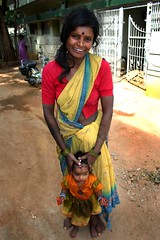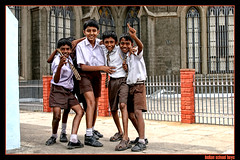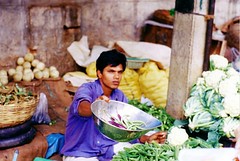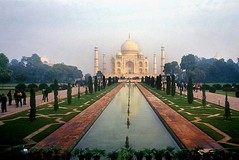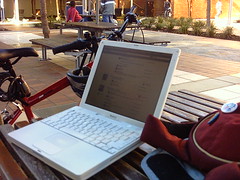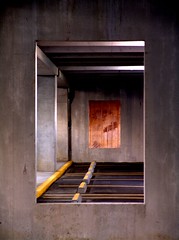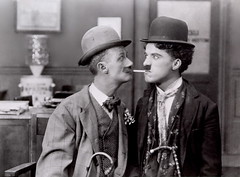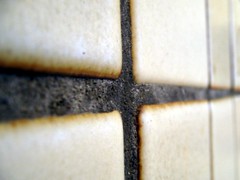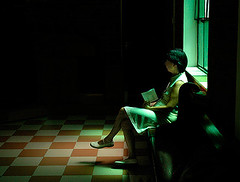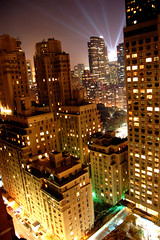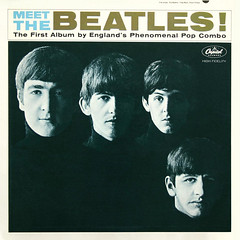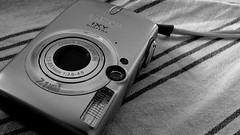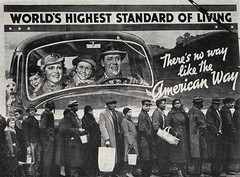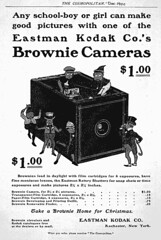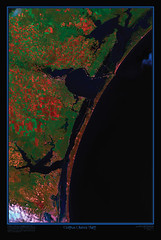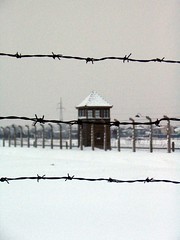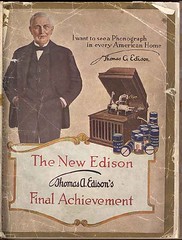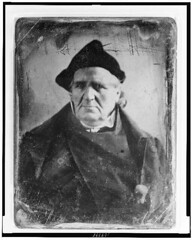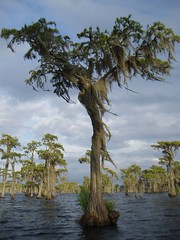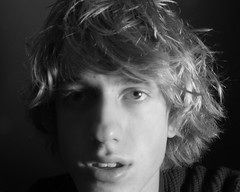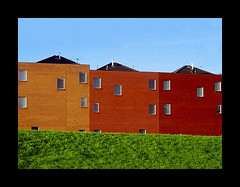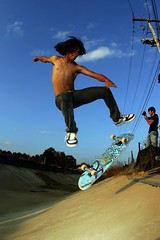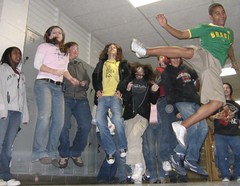Dell to Expand Its Operations in India Market
By SARITHA RAI
BANGALORE, India, Jan. 30 — Dell, the PC maker, will open a fourth call center in India, add 5,000 employees to its current 10,000 workers and begin manufacturing computers here, the company said Monday.
The president and chief executive of Dell, Kevin B. Rollins, said at a news conference in New Delhi that the new call center, planned for the nearby Gurgaon suburbs, would join Dell's current centers in Bangalore and Hyderabad in the south and Mohali in the north.
The Gurgaon center will open in April and employ 1,000 by the end of this year. Other workers will be added to other sites around India over the next two years.
Mr. Rollins's two-day visit to India ended Monday and included a meeting with Prime Minister Manmohan Singh.
Dell, which currently has less than 4 percent of India's annual market of four million computers, also said the company would set up a manufacturing base in India to help it increase its share of the country's fast-growing market, Mr. Rollins said. Sales of computers in India are expected to grow to 20 million a year in the next few years.
Dell, which is based in Round Rock, Tex., is one of several United States technology companies that have recently announced plans to increase operations in India. These companies are investing in India to take advantage of its English-speaking workers to write software and provide back-office support. Salaries in India are rising, but still are a fraction of salaries for comparable work in the West.
These companies are also eager to sell their wares in India. Microsoft, Intel and Cisco recently have announced investments of $1 billion or more, along with plans to increase employment.
Dell's customer support centers are part of a 30-center network worldwide. India is the only country in Dell's network that supports customers around the world.
"As we continue to attract new customers worldwide, our team in India has played a vital role in the company's operations," Mr. Rollins said in a statement.
Tuesday, January 31, 2006
Map of India Th, Feb 2; Yoga Day essay due Fri, Feb 10
Yoga Day illustrated essay (15 pts.)
* approx. 350 words researched via 2 sources.
* use "according to..." twice.
* titling, grammar.
* topics open:
- relationship between yoga and India.
_ relationship between yoga and the US.
_ relaxation, stress relief, alpha wave control.
_ yoga & gymnastics.
- yoga & history.
- vocabulary of yoga.
- other, please see me.
* yogi
* guru
* Lord Ganesh (Ganesha)
* Hindu vs. Muslim / partitioning of Pakistan & Bangladesh.
* Namaste'
* Little Black Sambo
* ethereal / Earthereal restaurant, Shreveport, vegetarian.
* tadasana
* approx. 350 words researched via 2 sources.
* use "according to..." twice.
* titling, grammar.
* topics open:
- relationship between yoga and India.
_ relationship between yoga and the US.
_ relaxation, stress relief, alpha wave control.
_ yoga & gymnastics.
- yoga & history.
- vocabulary of yoga.
- other, please see me.
* yogi
* guru
* Lord Ganesh (Ganesha)
* Hindu vs. Muslim / partitioning of Pakistan & Bangladesh.
* Namaste'
* Little Black Sambo
* ethereal / Earthereal restaurant, Shreveport, vegetarian.
* tadasana
Monday, January 30, 2006
Week of Jan 30: India map quiz, Taj Mahal, Gandhi
Namaste'!
Map of India
* Delhi/New Delhi
* Agra (home of the Taj Mahal)
* Bombay / Mumbai
* Calcutta / Kolkata
* Ganges R.
* Indian Ocean
* Arabian Sea
* Bay of Bengal
* Himalaya Mts.
* Nepal
* China
* Pakistan
* Bangladesh
* Sri Lanka (Ceylon)
Outsourcing / cheap workers overseas are given Americans' jobs so companies can remain competitive.
capitalism / free market; emphasis on competitiveness.
Bangalore: city in south of India notable for high-tech workforce (ex, Microsoft).
British Empire/ 1700's, 1800's, 1900's
"Sun never set on the British empire."
selected nations:
American colonies
Canada
Australia
Sudan
Jamaica
Bahamas
Iraq
Israel
Egypt
South Africa
Singapore
Hong Kong
Shanghai
Bollywood: melodramas
Map of India
* Delhi/New Delhi
* Agra (home of the Taj Mahal)
* Bombay / Mumbai
* Calcutta / Kolkata
* Ganges R.
* Indian Ocean
* Arabian Sea
* Bay of Bengal
* Himalaya Mts.
* Nepal
* China
* Pakistan
* Bangladesh
* Sri Lanka (Ceylon)
Outsourcing / cheap workers overseas are given Americans' jobs so companies can remain competitive.
capitalism / free market; emphasis on competitiveness.
Bangalore: city in south of India notable for high-tech workforce (ex, Microsoft).
British Empire/ 1700's, 1800's, 1900's
"Sun never set on the British empire."
selected nations:
American colonies
Canada
Australia
Sudan
Jamaica
Bahamas
Iraq
Israel
Egypt
South Africa
Singapore
Hong Kong
Shanghai
Bollywood: melodramas
English and Hindu-influenced English, or Hinglish
With English the commonly spoken language in India, Indians are contributing their bit at enrichment. The effect of Indian English, more commonly known as Hinglish as well as Indian words or Indianisms is being felt.
The latest edition of the Oxford English Dictionary (OED), considered the world’s favorite word store, is a reflection. The new collection of linguistic twisters (for Western people, that is) include “bindaas” (cool), “tamasha” (create a scene), “mehndi” (body color), “desi” (local) and “lehnga” (a form of dress). “Lollywood,” Lahore’s incipient film industry finds mention. So does “kitty party,” a social event for bored Indian housewives.
In an interview, the editor of the OED Catherine Soanes rejected criticism that misuse of English words was being legitimized. “We are merely reflecting the language as it is today,’’ she said. “Indian English is one of the growing areas of language, which is contributing to the language as a whole.’’
Indeed, it is not just the OED, the Collins English Dictionary has also included commonly used words by Indians. Distinctly Hindi words that form the vocabulary of a large section of English speaking Indians have been incorporated. They include “aunti-ji” and “uncle-ji,” “freshie” (a new immigrant), “filmi” (dramatic), “gora” (White), “kutta” (dog) and “kutti” (bitch), “haramzada” and “haramzadi” (bastards or obnoxious/despicable) and “yaar” (friend). In a statement the dictionary has officially acknowledged the role of Hinglish in the evolution of English.
Last year’s OED too had turned eclectic incorporating several Indianisms: “Adda” (local joint), “langar” (community eatery) and “dicky” (car), have become bona fide English words, adding to the Indian word store, which includes “Hindutva,” “history-sheeter” and others. Many words of daily use in English are of Indian origin, including words like “shampoo,” “bangle,” “bungalow,” “jungle,” “mantra,” “pundit” and “cot.” They figure in major English-language dictionaries.
Collins’ took the process further. Other words include “badmash” (bad person), “changa” (fine), “chuddie” (underwear), “desi” (native) and “machi chips,” Hinglish for the very English favorite, “fish and chips.” The words reflect the language commonly spoken by Asians in Britain imbibing a Punjabi flavor, thus denoting a meeting of cultures. Commonly used words in popular Asian soaps such as “The Kumars at Number 42’’ and “Silver Street,’’ which are watched by mainstream audiences, have been picked up. According to a statement by Collins, “the inclusion of Hinglish words in the Dictionary marks an exciting development and a new phase of borrowing by English.’’
“The beauty of English is that from the earliest times [India was a British colony] it has been able to incorporate and adapt words from other languages,’’ said editor in chief Jeremy Butterfield. “Already, we probably can’t get through the day without using several words derived from Indian languages. In the long run, we can expect Hinglish to influence English in many fields, in the same way that Latin and French have over several centuries.’’
Indeed, parents and schools across the world, including those in China, Germany and other non-English speaking European nations, want their kids to learn English, the only global instrument of communication. As cross-cultural exchanges happen and jobs require knowledge of English happen in a connected world, language remains in focus. There are reports that Indian call centers are advising their customer care executives to speak the native way rather than accented English to appeal to Western clients. The focus is on clarity and getting the problem solved rather than image to gain acceptance. This is in the wake of individual vigilantism due to job losses with racist and abusive hate calls aimed at harassing Indian call center operators.
According to Sabira Merchant, speech-voice consultant, on how Indians speak English, “Indians have excellent control over written English, yet when it comes to pronunciation, we do not always sound right. The problem is while Americans think in English, we think in our mother tongue and translate it while speaking. As a nation we do speak good English. That is why most Indians score easily over people of other nationalities. But, it will still take time for Indians to speak with a polished accent and fluency.’’
A group of such people working for MphasiS, a leading outsourcing provider, however had no such problems when they sweet talked American customers into blurting out credit card and bank account codes and passwords, using the same to transfer money to the tune of half a million dollars.
The outsourcing wave has helped India’s Silicon Valley, Bangalore, become the second modern city in the world to be turned into a verb after “shanghaied” — a word that broadly means to be forced to do something by fraud or coercion. To be shanghaied, in circulation since 1870, has acquired a 21st-century context due to Chinese goods flooding U.S. markets.
To be bangalored, yet to find mention in a dictionary, reflects the sentiments of those who have been laid off in the U.S. because their jobs have moved to Bangalore. “I am a software developer who is about to be bangalored. Fine. I am not going to pout about it,’’ a participant in an online forum wrote. Although there have been other geographical places that have been turned into words, called toponyms, (for example, “frankfurter” and “marathon), few cities have taken a verb form.
Indeed, as Hinglish enriches, Indians only try to be better at the original. The news from America is good as well. Indian American Anurag Kashyap, from Poway, California, has won the 78th Annual Scripps Howard National Spelling Bee competition. Anurag, 13, bagged the prize recently by spelling correctly the word “appoggiatura” (which means short note placed before a longer one). He had never used the musical word before he spelled it right to win the competition. Anurag took home $22,000 in cash, a $5,000 college scholarship, books and a $1,000 savings bond.
The Scripps Howard National Spelling Bee, a well established American tradition, has 273 finalists, aged 9 to 14, competing at a plush Washington, D.C., hotel. Many of them are children of immigrants, often under pressure to achieve by their parents’ desire to see them fitting in an alien society.
All three runners-up hail from South Asia. Another Indian American, Samir Sudhir Patel, 11, from Texas, settled for a second place tie. He was the youngest in the keenly contested rounds and lost the championship when he misspelled “roscian.’’
A cool Anurag coasted through the toughest words. Apart from the word that won him the title, he correctly spelt “cabochon,” “Priscilla,” “oligopsony,” “sphygmomanometer,” “prosciutto,” “rideau,” “pompier,” “terete,” “tristachyous,” “schefflera,” “ornithorhynchous,” “agio,” “agnolotti,” “peccavi,” “ceraunograph,” “exsiccosis” and “hodiernal.” Tough for anybody.
Source: http://www.worldpress.org/Asia/2143.cfm
The latest edition of the Oxford English Dictionary (OED), considered the world’s favorite word store, is a reflection. The new collection of linguistic twisters (for Western people, that is) include “bindaas” (cool), “tamasha” (create a scene), “mehndi” (body color), “desi” (local) and “lehnga” (a form of dress). “Lollywood,” Lahore’s incipient film industry finds mention. So does “kitty party,” a social event for bored Indian housewives.
In an interview, the editor of the OED Catherine Soanes rejected criticism that misuse of English words was being legitimized. “We are merely reflecting the language as it is today,’’ she said. “Indian English is one of the growing areas of language, which is contributing to the language as a whole.’’
Indeed, it is not just the OED, the Collins English Dictionary has also included commonly used words by Indians. Distinctly Hindi words that form the vocabulary of a large section of English speaking Indians have been incorporated. They include “aunti-ji” and “uncle-ji,” “freshie” (a new immigrant), “filmi” (dramatic), “gora” (White), “kutta” (dog) and “kutti” (bitch), “haramzada” and “haramzadi” (bastards or obnoxious/despicable) and “yaar” (friend). In a statement the dictionary has officially acknowledged the role of Hinglish in the evolution of English.
Last year’s OED too had turned eclectic incorporating several Indianisms: “Adda” (local joint), “langar” (community eatery) and “dicky” (car), have become bona fide English words, adding to the Indian word store, which includes “Hindutva,” “history-sheeter” and others. Many words of daily use in English are of Indian origin, including words like “shampoo,” “bangle,” “bungalow,” “jungle,” “mantra,” “pundit” and “cot.” They figure in major English-language dictionaries.
Collins’ took the process further. Other words include “badmash” (bad person), “changa” (fine), “chuddie” (underwear), “desi” (native) and “machi chips,” Hinglish for the very English favorite, “fish and chips.” The words reflect the language commonly spoken by Asians in Britain imbibing a Punjabi flavor, thus denoting a meeting of cultures. Commonly used words in popular Asian soaps such as “The Kumars at Number 42’’ and “Silver Street,’’ which are watched by mainstream audiences, have been picked up. According to a statement by Collins, “the inclusion of Hinglish words in the Dictionary marks an exciting development and a new phase of borrowing by English.’’
“The beauty of English is that from the earliest times [India was a British colony] it has been able to incorporate and adapt words from other languages,’’ said editor in chief Jeremy Butterfield. “Already, we probably can’t get through the day without using several words derived from Indian languages. In the long run, we can expect Hinglish to influence English in many fields, in the same way that Latin and French have over several centuries.’’
Indeed, parents and schools across the world, including those in China, Germany and other non-English speaking European nations, want their kids to learn English, the only global instrument of communication. As cross-cultural exchanges happen and jobs require knowledge of English happen in a connected world, language remains in focus. There are reports that Indian call centers are advising their customer care executives to speak the native way rather than accented English to appeal to Western clients. The focus is on clarity and getting the problem solved rather than image to gain acceptance. This is in the wake of individual vigilantism due to job losses with racist and abusive hate calls aimed at harassing Indian call center operators.
According to Sabira Merchant, speech-voice consultant, on how Indians speak English, “Indians have excellent control over written English, yet when it comes to pronunciation, we do not always sound right. The problem is while Americans think in English, we think in our mother tongue and translate it while speaking. As a nation we do speak good English. That is why most Indians score easily over people of other nationalities. But, it will still take time for Indians to speak with a polished accent and fluency.’’
A group of such people working for MphasiS, a leading outsourcing provider, however had no such problems when they sweet talked American customers into blurting out credit card and bank account codes and passwords, using the same to transfer money to the tune of half a million dollars.
The outsourcing wave has helped India’s Silicon Valley, Bangalore, become the second modern city in the world to be turned into a verb after “shanghaied” — a word that broadly means to be forced to do something by fraud or coercion. To be shanghaied, in circulation since 1870, has acquired a 21st-century context due to Chinese goods flooding U.S. markets.
To be bangalored, yet to find mention in a dictionary, reflects the sentiments of those who have been laid off in the U.S. because their jobs have moved to Bangalore. “I am a software developer who is about to be bangalored. Fine. I am not going to pout about it,’’ a participant in an online forum wrote. Although there have been other geographical places that have been turned into words, called toponyms, (for example, “frankfurter” and “marathon), few cities have taken a verb form.
Indeed, as Hinglish enriches, Indians only try to be better at the original. The news from America is good as well. Indian American Anurag Kashyap, from Poway, California, has won the 78th Annual Scripps Howard National Spelling Bee competition. Anurag, 13, bagged the prize recently by spelling correctly the word “appoggiatura” (which means short note placed before a longer one). He had never used the musical word before he spelled it right to win the competition. Anurag took home $22,000 in cash, a $5,000 college scholarship, books and a $1,000 savings bond.
The Scripps Howard National Spelling Bee, a well established American tradition, has 273 finalists, aged 9 to 14, competing at a plush Washington, D.C., hotel. Many of them are children of immigrants, often under pressure to achieve by their parents’ desire to see them fitting in an alien society.
All three runners-up hail from South Asia. Another Indian American, Samir Sudhir Patel, 11, from Texas, settled for a second place tie. He was the youngest in the keenly contested rounds and lost the championship when he misspelled “roscian.’’
A cool Anurag coasted through the toughest words. Apart from the word that won him the title, he correctly spelt “cabochon,” “Priscilla,” “oligopsony,” “sphygmomanometer,” “prosciutto,” “rideau,” “pompier,” “terete,” “tristachyous,” “schefflera,” “ornithorhynchous,” “agio,” “agnolotti,” “peccavi,” “ceraunograph,” “exsiccosis” and “hodiernal.” Tough for anybody.
Source: http://www.worldpress.org/Asia/2143.cfm
Girl Power and India's tennis star, Sania Mirza
India’s Tryst With “Girl Power”
Siddharth Srivastava
New Delhi, India
September 23, 2005
Tennis player Sania Mirza is just 18-years old and set to overtake the top celebrity brand endorsers in the country. This is India’s first taste of the “girl power” that has earned millions through corporate endorsements for the likes of Anna Kournikova and Maria Sharapova.
In India there have been broadly two categories of celebrities who garner most endorsement revenues — cricketers, who are treated like demigods, and film stars. Cricketers Sachin Tendulkar and Rahul Dravid, and film actors Shahrukh Khan and Amitabh Bachchan have been around for a while now, with Bachchan continuing his hold over the Indian masses despite being over 60 years old. Enter Sania.
Sania has been the subject of attention for a while, but it is at the U.S. Open tennis tournament that she really caught the eye of world audiences and sponsors. Americans had the first real look at the very pretty, athletically built, nose and ear-ringed Indian star at the tournament.
A mix of glamour, performance, a “bold and brazen” game plan, grit and attitude, suave and affable communication skills, “going for the kill” forehands, and record performances (by Indian standards and history that is) has perched Sania at the very top of Indian brand ambassadors.
Post her U.S. Open sojourn Sania has been pegged as the joint second highest grosser among sports stars, in the same bracket as Rahul Dravid.
In November last year she was valued under $15,000 per deal. Her current rate has reportedly crossed $400,000, an over 25-fold jump. Sania has been signed up by GVK Industries, Sahara India, Hindustan Petroleum, Tata Indicom, Atlas Cycles and Tata Tea. She has a three-year deal with Lotto Sport Italia, which has been endorsed by tennis icons from Boris Becker to Martina Navratilova. There are many more (some estimates put the number at more than 20) lining up at her door.
Tendulkar remains India’s only million-dollar sports star. His deal with World Tel nets him $5 million every year, though these figures are still dwarfed by global trends with golfer Tiger Woods estimated to earn over a billion dollars through endorsements and appearance fees. Baseball and basketball players in the United States and footballers in Europe are also well into the million dollar league.
The main reason that other sports stars fail to notch the mega deals in India is the abysmal level of sporting performances as reflected in the Athens Olympics where a country of over a billion people managed just one silver medal. Cricketers are worshipped because it is the only sport in which India manages to hold its own against the best teams, though the performance of the Indian team has been quite poor in the recent past. But, starved of sporting icons, cricketers continue to rake in the moola. There have been a sprinkling of super achievers such as Geet Sethi (billiards), Vishwanathan Anand (chess), Rajyavardhan Rathore (shooting), Anju George (long jump) but none have been able to match the appeal of cricketers. None, that is, until Sania came along.
There is no doubt that Sania has set new levels for achievement for Indian women, given the list of firsts: she has leaped 284 places to No. 42 in the tour rankings and is likely to touch under 35 soon. This is better than any other player within the same time span and the highest ever for an Indian woman. She became the first woman from India to reach the third round of a Grand Slam at the Australian Open in January this year, and then the first to win a tour title in Hyderabad shortly thereafter. She has beaten players in the top 10 and many of her opponents have commented on her potential. Many expect a Grand Slam victory.
Last week, she became the first Indian female to win a match at the U.S. Open. She was beaten by Sharapova in the pre-quarters after winning three rounds, but not without putting up a fight. She recently won the Arjuna award, one of India’s top sports awards.
Though there is a long way to go yet and many more battles to be won, she does provide a welcome relief through her performance and looks. One favorite media interest has been the way Sania has managed to displace the spotlight on cricketers, though she has been gracious enough to say that she is a big Tendulkar fan. On the day that she won a match at the U.S. Open, the Indian cricket team too scored a victory at a tri-series being played at Zimbabwe. Mohammed Kaif, a top cricketer, scored a fine century. It has been a while since such a performance was relegated to the inside sports pages. Sania, meanwhile, dominated the TV news, front page and lead stories. The editorials followed.
Corporate India of course is relishing the prospect of cashing in on Sania’s drawing power. The Sania-Sharapova encounter also saw a 15 percent jump in advertisement rates for a tennis match telecast in India. In keeping with the number of people staying up late at night in India (to keep U.S. time) to catch her on TV, she was assigned one of the three show courts with facility for direct telecast, for all her matches. In addition to the main sponsors Hero Honda and Pepsi, the U.S. Open matches saw heavy advertising by IBM, Hewlett Packard, Maruti, Tata Tea and Yamaha.
To the further delight of her sponsors, she minces no words in talking her mind as well, which goes to enhance her persona. “Fifty years ago, people in India didn’t believe that a woman could play a professional sport,” said Sania. “Girls like me coming out and playing on the world stage is a little shocking, but that’s changing, and I’m glad.”
Being a devout Muslim and belonging to a conservative set up (she prays five times a day, by her own admission), she is also an ambassador of India’s secular traditions that allows minority communities to prosper. On the flip side, her attire (mini skirts, that is) has already invited comments from cultural Cassandra’s (read Muslim clerics, who match point for point Hindu fundamentalists in their outdated viewpoints). They want her to wear long pants and full-sleeved shirts. Thankfully, they are okay with her playing and winning.
She has a retort for them too and is unlikely to heed their concern. “Not everyone is perfect and just because I wear a miniskirt or just because I’m wearing pants or whatever it is doesn’t make me a bad Muslim,” she says. “As long as I believe in God and I have my faith, I think that’s good.”
Indeed, Sania could go either way from here. She can be a version of Kournikova, who earned her millions with her fabulous looks. Or she could go the way of Sharapova, who has replaced Kournikova as the number one pinup and has become the numero uno player as well. As of now, all the signs show Sania seeking to emulate Sharapova. It is up to her from here. She will need to keep the balance.
Siddharth Srivastava
New Delhi, India
September 23, 2005
Tennis player Sania Mirza is just 18-years old and set to overtake the top celebrity brand endorsers in the country. This is India’s first taste of the “girl power” that has earned millions through corporate endorsements for the likes of Anna Kournikova and Maria Sharapova.
In India there have been broadly two categories of celebrities who garner most endorsement revenues — cricketers, who are treated like demigods, and film stars. Cricketers Sachin Tendulkar and Rahul Dravid, and film actors Shahrukh Khan and Amitabh Bachchan have been around for a while now, with Bachchan continuing his hold over the Indian masses despite being over 60 years old. Enter Sania.
Sania has been the subject of attention for a while, but it is at the U.S. Open tennis tournament that she really caught the eye of world audiences and sponsors. Americans had the first real look at the very pretty, athletically built, nose and ear-ringed Indian star at the tournament.
A mix of glamour, performance, a “bold and brazen” game plan, grit and attitude, suave and affable communication skills, “going for the kill” forehands, and record performances (by Indian standards and history that is) has perched Sania at the very top of Indian brand ambassadors.
Post her U.S. Open sojourn Sania has been pegged as the joint second highest grosser among sports stars, in the same bracket as Rahul Dravid.
In November last year she was valued under $15,000 per deal. Her current rate has reportedly crossed $400,000, an over 25-fold jump. Sania has been signed up by GVK Industries, Sahara India, Hindustan Petroleum, Tata Indicom, Atlas Cycles and Tata Tea. She has a three-year deal with Lotto Sport Italia, which has been endorsed by tennis icons from Boris Becker to Martina Navratilova. There are many more (some estimates put the number at more than 20) lining up at her door.
Tendulkar remains India’s only million-dollar sports star. His deal with World Tel nets him $5 million every year, though these figures are still dwarfed by global trends with golfer Tiger Woods estimated to earn over a billion dollars through endorsements and appearance fees. Baseball and basketball players in the United States and footballers in Europe are also well into the million dollar league.
The main reason that other sports stars fail to notch the mega deals in India is the abysmal level of sporting performances as reflected in the Athens Olympics where a country of over a billion people managed just one silver medal. Cricketers are worshipped because it is the only sport in which India manages to hold its own against the best teams, though the performance of the Indian team has been quite poor in the recent past. But, starved of sporting icons, cricketers continue to rake in the moola. There have been a sprinkling of super achievers such as Geet Sethi (billiards), Vishwanathan Anand (chess), Rajyavardhan Rathore (shooting), Anju George (long jump) but none have been able to match the appeal of cricketers. None, that is, until Sania came along.
There is no doubt that Sania has set new levels for achievement for Indian women, given the list of firsts: she has leaped 284 places to No. 42 in the tour rankings and is likely to touch under 35 soon. This is better than any other player within the same time span and the highest ever for an Indian woman. She became the first woman from India to reach the third round of a Grand Slam at the Australian Open in January this year, and then the first to win a tour title in Hyderabad shortly thereafter. She has beaten players in the top 10 and many of her opponents have commented on her potential. Many expect a Grand Slam victory.
Last week, she became the first Indian female to win a match at the U.S. Open. She was beaten by Sharapova in the pre-quarters after winning three rounds, but not without putting up a fight. She recently won the Arjuna award, one of India’s top sports awards.
Though there is a long way to go yet and many more battles to be won, she does provide a welcome relief through her performance and looks. One favorite media interest has been the way Sania has managed to displace the spotlight on cricketers, though she has been gracious enough to say that she is a big Tendulkar fan. On the day that she won a match at the U.S. Open, the Indian cricket team too scored a victory at a tri-series being played at Zimbabwe. Mohammed Kaif, a top cricketer, scored a fine century. It has been a while since such a performance was relegated to the inside sports pages. Sania, meanwhile, dominated the TV news, front page and lead stories. The editorials followed.
Corporate India of course is relishing the prospect of cashing in on Sania’s drawing power. The Sania-Sharapova encounter also saw a 15 percent jump in advertisement rates for a tennis match telecast in India. In keeping with the number of people staying up late at night in India (to keep U.S. time) to catch her on TV, she was assigned one of the three show courts with facility for direct telecast, for all her matches. In addition to the main sponsors Hero Honda and Pepsi, the U.S. Open matches saw heavy advertising by IBM, Hewlett Packard, Maruti, Tata Tea and Yamaha.
To the further delight of her sponsors, she minces no words in talking her mind as well, which goes to enhance her persona. “Fifty years ago, people in India didn’t believe that a woman could play a professional sport,” said Sania. “Girls like me coming out and playing on the world stage is a little shocking, but that’s changing, and I’m glad.”
Being a devout Muslim and belonging to a conservative set up (she prays five times a day, by her own admission), she is also an ambassador of India’s secular traditions that allows minority communities to prosper. On the flip side, her attire (mini skirts, that is) has already invited comments from cultural Cassandra’s (read Muslim clerics, who match point for point Hindu fundamentalists in their outdated viewpoints). They want her to wear long pants and full-sleeved shirts. Thankfully, they are okay with her playing and winning.
She has a retort for them too and is unlikely to heed their concern. “Not everyone is perfect and just because I wear a miniskirt or just because I’m wearing pants or whatever it is doesn’t make me a bad Muslim,” she says. “As long as I believe in God and I have my faith, I think that’s good.”
Indeed, Sania could go either way from here. She can be a version of Kournikova, who earned her millions with her fabulous looks. Or she could go the way of Sharapova, who has replaced Kournikova as the number one pinup and has become the numero uno player as well. As of now, all the signs show Sania seeking to emulate Sharapova. It is up to her from here. She will need to keep the balance.
India: demographics and background from CIA.gov
The Indus Valley civilization, one of the oldest in the world, dates back at least 5,000 years. Aryan tribes from the northwest invaded about 1500 B.C.; their merger with the earlier Dravidian inhabitants created the classical Indian culture. Arab incursions starting in the 8th century and Turkish in the 12th were followed by those of European traders, beginning in the late 15th century. By the 19th century, Britain had assumed political control of virtually all Indian lands. Indian armed forces in the British army played a vital role in both World Wars. Nonviolent resistance to British colonialism led by Mohandas GANDHI and Jawaharlal NEHRU brought independence in 1947. The subcontinent was divided into the secular state of India and the smaller Muslim state of Pakistan. A third war between the two countries in 1971 resulted in East Pakistan becoming the separate nation of Bangladesh. Despite impressive gains in economic investment and output, India faces pressing problems such as the ongoing dispute with Pakistan over Kashmir, massive overpopulation, environmental degradation, extensive poverty, and ethnic and religious strife.
slightly more than one-third the size of the US
border countries: Bangladesh 4,053 km, Bhutan 605 km, Burma 1,463 km, China 3,380 km, Nepal 1,690 km, Pakistan 2,912 km
Climate varies from tropical monsoon in south to temperate in north.
Terrain: upland plain (Deccan Plateau) in south, flat to rolling plain along the Ganges, deserts in west, Himalayas in north.
Natural resources: coal (fourth-largest reserves in the world), iron ore, manganese, mica, bauxite, titanium ore, chromite, natural gas, diamonds, petroleum, limestone, arable land.
Southern Asia, bordering the Arabian Sea and the Bay of Bengal, between Burma and Pakistan
Geographic coordinates:
20 00 N, 77 00 E
Map references:
Asia
Area:
total: 3,287,590 sq km
land: 2,973,190 sq km
water: 314,400 sq km
Area - comparative:
slightly more than one-third the size of the US
Land boundaries:
total: 14,103 km
border countries: Bangladesh 4,053 km, Bhutan 605 km, Burma 1,463 km, China 3,380 km, Nepal 1,690 km, Pakistan 2,912 km
Coastline:
7,000 km
Maritime claims:
territorial sea: 12 nm
contiguous zone: 24 nm
exclusive economic zone: 200 nm
continental shelf: 200 nm or to the edge of the continental margin
Climate:
varies from tropical monsoon in south to temperate in north
Terrain:
upland plain (Deccan Plateau) in south, flat to rolling plain along the Ganges, deserts in west, Himalayas in north
Elevation extremes:
lowest point: Indian Ocean 0 m
highest point: Kanchenjunga 8,598 m
Natural resources:
coal (fourth-largest reserves in the world), iron ore, manganese, mica, bauxite, titanium ore, chromite, natural gas, diamonds, petroleum, limestone, arable land
Land use:
arable land: 54.4%
permanent crops: 2.74%
other: 42.86% (2001)
Irrigated land:
Natural hazards: droughts; flash floods, as well as widespread and destructive flooding from monsoonal rains; severe thunderstorms; earthquakes.
Population: 1,080,264,388 (July 2005 est.)
Age structure:
0-14 years: 31.2% (male 173,634,432/female 163,932,475)
15-64 years: 63.9% (male 356,932,082/female 333,283,590)
65 years and over: 4.9% (male 26,542,025/female 25,939,784) (2005 est.)
Median age:
total: 24.66 years
male: 24.64 years
female: 24.67 years (2005 est.)
Population growth rate: 1.4% (2005 est.)
Birth rate: 22.32 births/1,000 population (2005 est.)
Death rate: 8.28 deaths/1,000 population (2005 est.)
Major infectious diseases:
degree of risk: high
food or waterborne diseases: bacterial diarrhea, hepatitis A and E, and typhoid fever
vectorborne diseases: dengue fever, malaria, and Japanese encephalitis are high risks in some locations.
HIV/AIDS - adult prevalence rate: 0.9% (2001 est..)
HIV/AIDS - people living with HIV/AIDS: 5.1 million (2001 est.).
Ethnic groups:
Indo-Aryan 72%, Dravidian 25%, Mongoloid and other 3% (2000)
Religions:
Hindu 80.5%, Muslim 13.4%, Christian 2.3%, Sikh 1.9%, other 1.8%, unspecified 0.1% (2001 census)
Languages:
English enjoys associate status but is the most important language for national, political, and commercial communication; Hindi is the national language and primary tongue of 30% of the people; there are 14 other official languages: Bengali, Telugu, Marathi, Tamil, Urdu, Gujarati, Malayalam, Kannada, Oriya, Punjabi, Assamese, Kashmiri, Sindhi, and Sanskrit; Hindustani is a popular variant of Hindi/Urdu spoken widely throughout northern India but is not an official language.
Literacy:
definition: age 15 and over can read and write
total population: 59.5%
male: 70.2%
female: 48.3% (2003 est.).
Economy - overview:
India's diverse economy encompasses traditional village farming, modern agriculture, handicrafts, a wide range of modern industries, and a multitude of services. Services are the major source of economic growth, accounting for half of India's output with less than one quarter of its labor force. About two-thirds of the workforce is in agriculture, leading the UPA government to articulate an economic reform program that includes developing basic infrastructure to improve the lives of the rural poor and boost economic performance. Government controls on foreign trade and investment have been reduced in some areas, but high tariffs (averaging 20% on non-agricultural items in 2004) and limits on foreign direct investment are still in place. The government in 2005 liberalized investment in the civil aviation, telecom, and construction sectors. Privatization of government-owned industries essentially came to a halt in 2005, and continues to generate political debate; continued social, political, and economic rigidities hold back needed initiatives. The economy has posted an excellent average growth rate of more than 6.8% in the decade since 1994, reducing poverty by about 10 percentage points. India probably achieved greater than 7 percent GDP growth in 2005, significantly expanding manufacturing. India is capitalizing on its large numbers of well-educated people skilled in the English language to become a major exporter of software services and software workers. Despite strong growth, the World Bank and others worry about the combined state and federal budget deficit, running at approximately 9% of GDP. The huge and growing population is the fundamental social, economic, and environmental problem.
GDP - per capita: purchasing power parity - $3,400 (2005 est.).
Labor force - by occupation: agriculture 60%, industry 17%, services 23% (1999)
Unemployment rate: 9% (2005 est.)
Population below poverty line: 25% (2002 est.)
Agriculture - products: rice, wheat, oilseed, cotton, jute, tea, sugarcane, potatoes; cattle, water buffalo, sheep, goats, poultry; fish.
Industries: textiles, chemicals, food processing, steel, transportation equipment, cement, mining, petroleum, machinery, software.
Exports - partners: US 17%, UAE 8.8%, China 5.5%, Hong Kong 4.7%, UK 4.5%, Singapore 4.5% (2004)
Imports - partners: China 6.1%, US 6%, Switzerland 5.2%, Belgium 4.4% (2004)
Internet users: 18.481 million (2003)
Illicit drugs: world's largest producer of licit opium for the pharmaceutical trade, but an undetermined quantity of opium is diverted to illicit international drug markets; transit point for illicit narcotics produced in neighboring countries; illicit producer of methaqualone; vulnerable to narcotics money laundering through the hawala system.
Disputes - international: China and India launched a security and foreign policy dialogue in 2005, consolidating discussions related to the dispute over most of their rugged, militarized boundary, regional nuclear proliferation, Indian claims that China transferred missiles to Pakistan, and other matters; recent talks and confidence-building measures have begun to defuse tensions over Kashmir, site of the world's largest and most militarized territorial dispute with portions under the de facto administration of China (Aksai Chin), India (Jammu and Kashmir), and Pakistan (Azad Kashmir and Northern Areas); in 2004, India and Pakistan instituted a cease fire in the Kashmir and in 2005, restored bus service across the highly militarized Line of Control; Pakistan has taken its dispute on the impact and benefits of India's building the Baglihar dam on the Chenab River in Jammu and Kashmir to the World Bank for arbitration.
Sunday, January 29, 2006
Taj Mahal: a Muslim tomb and Mughal monument
The Taj Mahal Is a Glorious Survivor
By AMY WALDMAN / NYTimes
THE most famous narrative of the Taj Mahal, India's transcendent tourist attraction, is the love story that prompted its construction: the death of queen Mumtaz during the birth of her 14th child; the grief of her emperor-husband, Shah Jahan; and his vow to build the world's greatest monument to love.
But after more than 350 years, there are other narratives worth exploring as well, including India's own complicated relationship with the monument, and with the Islamic emperors who built it and many of this country's architectural treasures.
There is the survivor's narrative of a monument that has been plundered, nearly dismantled, and eroded by pollution. Read enough of the history, and it seems a wonder it is standing at all.
Then there is the narrative of visiting it. The Taj has been so hyped through time that seeing it seems destined to be an anticlimax. But it isn't. The tomb's whiteness, its symmetry, its curves, majestic scale and exquisite detail are unreal.
Unfortunately, visiting it is a little too real. The Taj is set in Agra, an overcrowded city whose population has far surpassed its support system. After three trips to the Taj with different guests, I have come to dread the heat, the hawkers, the haphazardness of its surroundings - always vowing that this visit will be the last. Then I see the ethereal dome framed in the gateway that ensures a dramatic entrance and cannot wait to return.
The Taj is one of those rare creations that work from a distance and up close, as a whole and in parts, and in totally different ways. It has had its critics ("Marble, I perceive, covers a multitude of sins," Aldous Huxley wrote), but they are few.
The tomb is set against river and sky, the hue of its marble changing in the day's light. The perfect shape of the dome is reflected in the long rectangular pool in front. The almost womanly nature of the building's curves offsets the more severe formality of its planes. The white marble contrasts beautifully with the red sandstone of the mosque and its matching jawab, or answer - the two buildings that flank the tomb - and the greenery of the gardens.
The interior bears a totally different kind of scrutiny, to perceive the intricacy and color of the flowers that decorate the marble surface and delicacy of the almost lacy marble screen that surrounds the queen's tomb. Outside, the gardens - the Moguls' signature - today are significantly altered from the Mogul era, but they are respectably maintained. You can, and should, walk the periphery of the tomb, both to appreciate the building and its relationship to the river and also the Indian families, lovers and tourists who come en masse to see their country's great treasure.
The Taj Mahal has become the most identifiable symbol of India, drawing 2.2 million tourists a year. People visit for the romance, although it is not a particularly romantic experience. But in an age obsessed with Islamic extremism, it is also worth viewing as a manifestation of another side of Islamic civilization.
Those who talk about the lost glory of Islam and how the loss has helped feed Muslim anger can find that glory in the Taj and its marriage of architecture, design and engineering. It is one of the world's most spectacular examples of Islamic art, albeit melded with Persian, Indian and Central Asian influences. It represents the culmination of an empire that, if not always benevolent, did provide India with much of its modern-day structure and administrative foundation.
Shah Jahan - "Emperor of the World" - was one of a series of Mogul, or Muslim, emperors who ruled India from the 16th to 18th centuries. Theirs was a civilization that contained both cruelty and justice, excess and refinement. The emperors were great patrons of the arts and artisans, students of science and architecture and gardens.
The Taj is a wonder in the best sense, in that much of what makes it work is invisible. The double layer dome. The calligraphers' artfulness in gradually increasing the height of letters in the Koranic scriptures on the exterior so that they look uniform. The ingenious underground pipes that supplied water to the channels in the charbagh, or foursquare garden.
But India is a majority Hindu nation, until last week's election controlled by Hindu nationalists whose b? noire is the Muslim invaders who built the Taj. The Moguls were marauding conquerors who brutalized the bodies, psyches, and monuments of Hindu India. But they au.also gave the country many of its most beautiful buildings and gardens, which lie almost casually studded throughout Delhi and Agra and nearby Fatepur Sikri, the fabulous abandoned city built by Akbar.
Some ardent Hindu nationalists ignore this; others deny it altogether. In our office library I recently unearthed a small volume called the "The Taj Mahal Is a Temple Palace," by one P. N. Oak in 1974, and billed as "An Epoch-Making Discovery Which Has Proved All Histories and Historians Wrong." He argues that the Taj was "built by a powerful Rajput king in pre-Muslim times," constructed "of the Hindus, for the Hindus and by the Hindus."
Most historians, of course, disagree; it is clearly established that the Taj was built by Shah Jahan, the son of Jahangir, the Mogul emperor. Shah Jahan reputedly chose Arjumand Banu, renamed Mumtaz Mahal - "chosen one of the palace" - as a wife at a noble ladies' bazaar. Inflated through the ages into an almost impossibly beautiful, virtuous and brave woman, despite a fairly scanty historical record, Mumtaz Mahal accompanied him to war, and bore him 14 children, the last birth killing her at the age of 39. In death she became her bereft husband's muse.
Like most great monuments, the Taj is a testament to the excesses of its time. The Moguls were given to outrageous collections and displays of wealth. So it was that 20,000 laborers (Kipling wrote of the "sorrow of the workmen who died in the building - used up like cattle") spent 22 years to fulfill Shah Jahan's fancy, with jewels, materials and craftsmen imported from China, Baghdad, Afghanistan and elsewhere.
But its story is also about a struggle between tolerance and extremism within Islam that continues to this day. Shah Jahan was imprisoned by his son Aurangzeb, who succeeded him and reportedly disapproved of his father's profligacy. Discarding the relative tolerance of his forebears, Aurangzeb brought a Taliban-style rule, trying to impose a literal Islam and persecuting and penalizing Hindus and others.
Shah Jahan had sought perfect symmetry in the Taj, and placed the tomb of Mumtaz (actually a marble cenotaph; her body is buried below) squarely at the center, forming a perfect sightline out the entrance. Aurangzeb spoiled that symmetry by placing his father's tomb inside as well.
Some say that was because he felt guilty over how he had treated his father and wanted to make amends. On my last trip, my guide said it was because Aurangzeb deliberately sought to ruin the symmetry because under Islam, symmetry should be reserved for God. "He was a fanatic Muslim," the guide, a Hindu Brahmin, said. Whether that particular detail is true or not, Aurangzeb's fanaticism ultimately led to the decline of the Mogul empire, prompting revolts among different subject groups.
Aurangzeb did preserve the tomb at the Taj as a sacred space, and for years, the Koran was continually read here by mullahs. That custom ended as the Mogul empire declined, and the British empire began to coalesce.
The British, along with the Jats, a caste of northern India, looted the Taj of the lavish carpets, jewels, silver doors and tapestries that once bedecked it. Lord William Bentinck, the first governor-general of India, even planned to dismantle the Taj and sell off the marble. And by the mid-19th century, according to D. N. Dube and Shalini Saran in "Taj Mahal," a small, readable guide published by Roli Books International in 1985, the Taj had become a colonial "pleasure resort," with Englishmen and women dancing on the terrace, and the mosque and its jawab rented out to honeymooners.
Lord Curzon, who did more than any Englishman to preserve the Taj and other monuments, noted that picnickers often came armed with hammer and chisel, the better to extract fragments of agate and carnelian from the flowers. He repaired the buildings, restored the gardens, although with a British touch, and got the canals working again.
It is easy to revile the British treatment of the Taj, but the Indians haven't always done much better. As Agra grew, little effort was made to spare the Taj the ravages of pollution, which began to discolor the white marble. In the late 1990's, as the monument's future began to seem deeply imperiled, the Supreme Court ordered the shifting of some industries farther away.
Today, only electric-powered vehicles (or bicycle rickshaws) are allowed near the Taj, and under a public-private partnership between the government and the Taj Group of hotels, a major conservation effort is under way. Moving slowly, thanks to unwieldy bureaucracy, but steadily, a group of global experts has spent more than two years researching and documenting the monument. Soon the real work on the ground will begin. First the visitor facilities - toilets, drinking water and the like - will be improved, and security made less obtrusive. Then will come questions like how to improve the visitor flow through the site and whether to restore the gardens to their original state or preserve the lawns that were installed by Lord Curzon.
A persistent conservation effort seems essential, given the continuing threats to the monument. A scandal erupted after the government of Uttar Pradesh, the state where the Taj sits, allowed construction to start on a Taj Heritage Corridor, which included a shopping mall between the Taj and Agra Fort, without securing the permission of the central government. The project was scrapped amid fears that it could damage the Taj, not to mention its ambience, and the state's former chief minister, Mayawati, is being investigated for corruption in connection with the project.
For now, the Taj endures, its elegance in contrast to the slums that house nearly half of Agra's 1.5 million people.
In the words of the Indian publication Outlook Traveller, "Whatever mileage the city gets out of the country's most celebrated building, it loses in the fact that you step out of it into filth."
You can avoid some of the unpleasantness by taking an air-conditioned bus tour, as my friend Christine and I did recently. Most tours also stop at Akbar's tomb and Agra Fort, both definitely worth seeing. A tour will spare you much harassment, but is expensive, and subject to the whim of a guide; the one we had rushed us through the riveting 16th-century Agra Fort, then forced us to linger endlessly at a souvenir shop.
For more control of your time, you can take the train to Agra or drive the 125 miles from Delhi. Either way, you will leave your car or a taxi at the required distance, and hire a bicycle rickshaw or motorized vehicle (or walk) to reach the monument. Most transport will drop you at the eastern or western gate, where you will buy tickets, but if you can, make your way to the southern gate - it allows for the most dramatic entrance, in which you move from a medieval city quarter into a garden of paradise.
As a foreigner, you will pay $16 and be required to buy a "day pass" to visit all the monuments - Agra Fort, and others - even if you do not plan to visit them. Day pass is a misnomer: even if you buy it, you must pay additional fees at the other monuments.
Getting into the Taj can leave you fairly ragged, between multiple pat-downs by security guards, innumerable government-approved guides wanting to sell their services, and having to check your electronic devices, often with extortionists who demand to be paid. On your way out, the hawkers will pounce.
The Taj, the Agra Fort and Fatepur Sikri are all in Uttar Pradesh, one of India's poorest, most populous states. Unemployment is extremely high, and you cannot blame residents for viewing the monuments and the foreign tourists they draw as an economic lifeline. Desperation sometimes manifests as aggression.
There may be no more brutal, surreal metaphor for that than what one sees on the road between the Taj and Fatepur Sikri; it is lined with men with dancing bears. As cars approach, the small bears are yanked up on their hind legs in the hope of extracting a few rupees from passing motorists.
But perhaps a certain arduousness in visiting the Taj only adds to its effect. Somehow, after navigating the chaos, its beauty is even more remarkable, perhaps more unexpected, when it first floats into view, an image serene and perfect enough to tattoo inside an eyelid.
By AMY WALDMAN / NYTimes
THE most famous narrative of the Taj Mahal, India's transcendent tourist attraction, is the love story that prompted its construction: the death of queen Mumtaz during the birth of her 14th child; the grief of her emperor-husband, Shah Jahan; and his vow to build the world's greatest monument to love.
But after more than 350 years, there are other narratives worth exploring as well, including India's own complicated relationship with the monument, and with the Islamic emperors who built it and many of this country's architectural treasures.
There is the survivor's narrative of a monument that has been plundered, nearly dismantled, and eroded by pollution. Read enough of the history, and it seems a wonder it is standing at all.
Then there is the narrative of visiting it. The Taj has been so hyped through time that seeing it seems destined to be an anticlimax. But it isn't. The tomb's whiteness, its symmetry, its curves, majestic scale and exquisite detail are unreal.
Unfortunately, visiting it is a little too real. The Taj is set in Agra, an overcrowded city whose population has far surpassed its support system. After three trips to the Taj with different guests, I have come to dread the heat, the hawkers, the haphazardness of its surroundings - always vowing that this visit will be the last. Then I see the ethereal dome framed in the gateway that ensures a dramatic entrance and cannot wait to return.
The Taj is one of those rare creations that work from a distance and up close, as a whole and in parts, and in totally different ways. It has had its critics ("Marble, I perceive, covers a multitude of sins," Aldous Huxley wrote), but they are few.
The tomb is set against river and sky, the hue of its marble changing in the day's light. The perfect shape of the dome is reflected in the long rectangular pool in front. The almost womanly nature of the building's curves offsets the more severe formality of its planes. The white marble contrasts beautifully with the red sandstone of the mosque and its matching jawab, or answer - the two buildings that flank the tomb - and the greenery of the gardens.
The interior bears a totally different kind of scrutiny, to perceive the intricacy and color of the flowers that decorate the marble surface and delicacy of the almost lacy marble screen that surrounds the queen's tomb. Outside, the gardens - the Moguls' signature - today are significantly altered from the Mogul era, but they are respectably maintained. You can, and should, walk the periphery of the tomb, both to appreciate the building and its relationship to the river and also the Indian families, lovers and tourists who come en masse to see their country's great treasure.
The Taj Mahal has become the most identifiable symbol of India, drawing 2.2 million tourists a year. People visit for the romance, although it is not a particularly romantic experience. But in an age obsessed with Islamic extremism, it is also worth viewing as a manifestation of another side of Islamic civilization.
Those who talk about the lost glory of Islam and how the loss has helped feed Muslim anger can find that glory in the Taj and its marriage of architecture, design and engineering. It is one of the world's most spectacular examples of Islamic art, albeit melded with Persian, Indian and Central Asian influences. It represents the culmination of an empire that, if not always benevolent, did provide India with much of its modern-day structure and administrative foundation.
Shah Jahan - "Emperor of the World" - was one of a series of Mogul, or Muslim, emperors who ruled India from the 16th to 18th centuries. Theirs was a civilization that contained both cruelty and justice, excess and refinement. The emperors were great patrons of the arts and artisans, students of science and architecture and gardens.
The Taj is a wonder in the best sense, in that much of what makes it work is invisible. The double layer dome. The calligraphers' artfulness in gradually increasing the height of letters in the Koranic scriptures on the exterior so that they look uniform. The ingenious underground pipes that supplied water to the channels in the charbagh, or foursquare garden.
But India is a majority Hindu nation, until last week's election controlled by Hindu nationalists whose b? noire is the Muslim invaders who built the Taj. The Moguls were marauding conquerors who brutalized the bodies, psyches, and monuments of Hindu India. But they au.also gave the country many of its most beautiful buildings and gardens, which lie almost casually studded throughout Delhi and Agra and nearby Fatepur Sikri, the fabulous abandoned city built by Akbar.
Some ardent Hindu nationalists ignore this; others deny it altogether. In our office library I recently unearthed a small volume called the "The Taj Mahal Is a Temple Palace," by one P. N. Oak in 1974, and billed as "An Epoch-Making Discovery Which Has Proved All Histories and Historians Wrong." He argues that the Taj was "built by a powerful Rajput king in pre-Muslim times," constructed "of the Hindus, for the Hindus and by the Hindus."
Most historians, of course, disagree; it is clearly established that the Taj was built by Shah Jahan, the son of Jahangir, the Mogul emperor. Shah Jahan reputedly chose Arjumand Banu, renamed Mumtaz Mahal - "chosen one of the palace" - as a wife at a noble ladies' bazaar. Inflated through the ages into an almost impossibly beautiful, virtuous and brave woman, despite a fairly scanty historical record, Mumtaz Mahal accompanied him to war, and bore him 14 children, the last birth killing her at the age of 39. In death she became her bereft husband's muse.
Like most great monuments, the Taj is a testament to the excesses of its time. The Moguls were given to outrageous collections and displays of wealth. So it was that 20,000 laborers (Kipling wrote of the "sorrow of the workmen who died in the building - used up like cattle") spent 22 years to fulfill Shah Jahan's fancy, with jewels, materials and craftsmen imported from China, Baghdad, Afghanistan and elsewhere.
But its story is also about a struggle between tolerance and extremism within Islam that continues to this day. Shah Jahan was imprisoned by his son Aurangzeb, who succeeded him and reportedly disapproved of his father's profligacy. Discarding the relative tolerance of his forebears, Aurangzeb brought a Taliban-style rule, trying to impose a literal Islam and persecuting and penalizing Hindus and others.
Shah Jahan had sought perfect symmetry in the Taj, and placed the tomb of Mumtaz (actually a marble cenotaph; her body is buried below) squarely at the center, forming a perfect sightline out the entrance. Aurangzeb spoiled that symmetry by placing his father's tomb inside as well.
Some say that was because he felt guilty over how he had treated his father and wanted to make amends. On my last trip, my guide said it was because Aurangzeb deliberately sought to ruin the symmetry because under Islam, symmetry should be reserved for God. "He was a fanatic Muslim," the guide, a Hindu Brahmin, said. Whether that particular detail is true or not, Aurangzeb's fanaticism ultimately led to the decline of the Mogul empire, prompting revolts among different subject groups.
Aurangzeb did preserve the tomb at the Taj as a sacred space, and for years, the Koran was continually read here by mullahs. That custom ended as the Mogul empire declined, and the British empire began to coalesce.
The British, along with the Jats, a caste of northern India, looted the Taj of the lavish carpets, jewels, silver doors and tapestries that once bedecked it. Lord William Bentinck, the first governor-general of India, even planned to dismantle the Taj and sell off the marble. And by the mid-19th century, according to D. N. Dube and Shalini Saran in "Taj Mahal," a small, readable guide published by Roli Books International in 1985, the Taj had become a colonial "pleasure resort," with Englishmen and women dancing on the terrace, and the mosque and its jawab rented out to honeymooners.
Lord Curzon, who did more than any Englishman to preserve the Taj and other monuments, noted that picnickers often came armed with hammer and chisel, the better to extract fragments of agate and carnelian from the flowers. He repaired the buildings, restored the gardens, although with a British touch, and got the canals working again.
It is easy to revile the British treatment of the Taj, but the Indians haven't always done much better. As Agra grew, little effort was made to spare the Taj the ravages of pollution, which began to discolor the white marble. In the late 1990's, as the monument's future began to seem deeply imperiled, the Supreme Court ordered the shifting of some industries farther away.
Today, only electric-powered vehicles (or bicycle rickshaws) are allowed near the Taj, and under a public-private partnership between the government and the Taj Group of hotels, a major conservation effort is under way. Moving slowly, thanks to unwieldy bureaucracy, but steadily, a group of global experts has spent more than two years researching and documenting the monument. Soon the real work on the ground will begin. First the visitor facilities - toilets, drinking water and the like - will be improved, and security made less obtrusive. Then will come questions like how to improve the visitor flow through the site and whether to restore the gardens to their original state or preserve the lawns that were installed by Lord Curzon.
A persistent conservation effort seems essential, given the continuing threats to the monument. A scandal erupted after the government of Uttar Pradesh, the state where the Taj sits, allowed construction to start on a Taj Heritage Corridor, which included a shopping mall between the Taj and Agra Fort, without securing the permission of the central government. The project was scrapped amid fears that it could damage the Taj, not to mention its ambience, and the state's former chief minister, Mayawati, is being investigated for corruption in connection with the project.
For now, the Taj endures, its elegance in contrast to the slums that house nearly half of Agra's 1.5 million people.
In the words of the Indian publication Outlook Traveller, "Whatever mileage the city gets out of the country's most celebrated building, it loses in the fact that you step out of it into filth."
You can avoid some of the unpleasantness by taking an air-conditioned bus tour, as my friend Christine and I did recently. Most tours also stop at Akbar's tomb and Agra Fort, both definitely worth seeing. A tour will spare you much harassment, but is expensive, and subject to the whim of a guide; the one we had rushed us through the riveting 16th-century Agra Fort, then forced us to linger endlessly at a souvenir shop.
For more control of your time, you can take the train to Agra or drive the 125 miles from Delhi. Either way, you will leave your car or a taxi at the required distance, and hire a bicycle rickshaw or motorized vehicle (or walk) to reach the monument. Most transport will drop you at the eastern or western gate, where you will buy tickets, but if you can, make your way to the southern gate - it allows for the most dramatic entrance, in which you move from a medieval city quarter into a garden of paradise.
As a foreigner, you will pay $16 and be required to buy a "day pass" to visit all the monuments - Agra Fort, and others - even if you do not plan to visit them. Day pass is a misnomer: even if you buy it, you must pay additional fees at the other monuments.
Getting into the Taj can leave you fairly ragged, between multiple pat-downs by security guards, innumerable government-approved guides wanting to sell their services, and having to check your electronic devices, often with extortionists who demand to be paid. On your way out, the hawkers will pounce.
The Taj, the Agra Fort and Fatepur Sikri are all in Uttar Pradesh, one of India's poorest, most populous states. Unemployment is extremely high, and you cannot blame residents for viewing the monuments and the foreign tourists they draw as an economic lifeline. Desperation sometimes manifests as aggression.
There may be no more brutal, surreal metaphor for that than what one sees on the road between the Taj and Fatepur Sikri; it is lined with men with dancing bears. As cars approach, the small bears are yanked up on their hind legs in the hope of extracting a few rupees from passing motorists.
But perhaps a certain arduousness in visiting the Taj only adds to its effect. Somehow, after navigating the chaos, its beauty is even more remarkable, perhaps more unexpected, when it first floats into view, an image serene and perfect enough to tattoo inside an eyelid.
The bindi and the impact of elegant Indian style
Red forehead dot: bindi
Bindi is derived from the Sanskrit word "Bindu" or a drop. It is supposed to signify the mystic third eye of a person and therefore, when properly marked, becomes the central point of the base of the creation itself. It is a symbol of auspiciousness, good fortune and festivity.
Why Bindi?
The very positioning of the bindi is significant. The area between the eyebrows is the seat of latent wisdom. This area is known as the "Agna" (6th chakra) meaning "command". It is said to control various levels of concentration attained through meditation. The central point of this area is the "Bindu" wherein all experience is gathered in total concentration. Tantric tradition has it that during meditation, the "kundalini" - the latent energy that lies at the base of the spine is awakened and rises to the point of sahasrara (7th chakra) situated in the head or brain. The central point, the bindu, becomes therefore a possible outlet for this potent energy. It is believed that the red kumkum lies between the eyebrows to retain energy in the human body.
Myths and Significance - The color red
Bindi, which is often described as Sindhura or Tilaka, means red, and Gandha, which is also a term for Tilaka, means pleasant odour. The colour red is significant. Red represents Shakti (strength). The red colour, some believe, symbolizes the far more ancient practice of offering blood sacrifices to propitiate the Gods - particularly the Goddess Shakti. In time, communities put an end to actual sacrifices and offered gifts instead, but the colour red remained. Red, it is believed, symbolizes love. The yellow of the spice turmeric has the power to influence the intellect. That is why the red kumkum and the yellow turmeric are placed side by side in temples or in any homes during a celebration. Both are offered to women at the time of leave-taking in certain parts of the country. This is to express goodwill and the hosts' prayers for the visitors' continued good fortune.
Some scholars have seen the red colour as a symbolism for blood. We are told that in ancient times, in Aryan society, a groom used to apply his blood on his bride's forehead as recognition of wedlock. The existing practice among Indian women of applying a round shaped red Tilaka called Bindiya or Kumkum could be a survival of this.
It denotes the woman's married status in most of the North Indian communities but in South India it is a prerogative of all girls to wear a bindi. The bridegroom's make-up is incomplete without the Tilaka. The decked North Indian bride steps over the threshold of her married home, resplendent with the red bindi on her forehead. The red color is supposed to augur prosperity for the home she is entering. The mark makes her the preserver of the family's welfare and progeny.
Significantly when an Indian woman has the misfortune of becoming a widow she has to stop wearing this mark. In a woman's case a Tilaka is a sign of her being in wedlock. Among men, the Tilaka has been traditionally interpreted as a good luck charm.
Conservative women still use ages old kumkum or sindoor for making a bindi. In olden days, to get a perfect round they used to use a small circular disc or a hollow pie coin. First a sticky wax paste or Vaseline was applied on the empty space in the disc. This was then covered with kumkum and then the disc was removed.... and presto you had a perfect round bindi. Today, the kumkum has been largely replaced by the "sticker-bindi". Made of felt, with glue on one side, this is an ingenious, easy-to-use substitute. The sticker-bindi comes in all colours and design, sequinned, dusted with gold powder, studded with beads and glittering stones and in different sizes. Some are truly exotic creations, using thin metal, in gold and silver colours, encrusted with glittering stones.
The bindi today is a fashion statement. Apparently, one that is sweeping the West, judging by the number of young performers sporting bindis on music channels. The bindi is an adornment that lights up your face and gives it a focal point. Bindi, on the beloved's forehead is supposed to mesmerise her lover. Poets, through ages have composed couplets on the beautiful bindiya of the damsel. The bindi still attracts a lot of attention, as it is the first thing that catches our eye. This little dot has always received a place of importance in Indian customs. The bindi carries with it a wealth of meaning and is an on-going link with a very ancient tradition and past.
A little more about KUMKUM
Kumkum attains special importance in temples dedicated to Shakti, Lakshmi and in other Vaishnavite temples. Kumkum is of special significance of Fridays and special occasions. The little red kumkum has a long and ancient tradition. A silent watcher, the kumkum has travelled through our 5000-year-old culture. Our religious texts, scriptures, myths and epics mention the kumkum. Radha turned the kumkum into a flame- like design on her forehead, it is said. Draupadi, in despair and disillusion, wiped the kumkum off her forehead on that dark day at Hastinapur. The practice of using kumkum on foreheads is mentioned in many ancient texts - the Puranas, Lalitha Sahasranamam, Soundarya Lahhari to name a few.
In the old days, materials like chandhanam, aguru, kasturi, kumkum and sindoor were used to make the tika. Women also ground saffron together with the kusumbha flower to create a paste to use on their foreheads.
Kumkum and sindoor are of two different materials. Kumkum is made of red turmeric. Sindoor, worn on the centre parting of the hair, is used in certain parts of the country. Red in colour, it is made of zinc oxide.
Both sindoor and kumkum are auspicious. Both stand for good fortune and signs of "Soubhagya" in the case of a married woman. Men wore the mystic central vermilion dot as a mark of spiritual intelligence. The forehead dot known as the "urna" is found on the 2nd and 3rd century AD sculptures of Lord Buddha. Today, most men wear kumkum specifically during worship or religious ceremonies.
The kumkum, apart from being an auspicious adornment, also played the role of a silent communicator in the old days. Women who had lost their husbands did not wear kumkum. If there was a death in the family, women did not wear kumkum. Many married women would use turmeric as a substitute merely to indicate, not widowhood, but a state of mourning in the family.
http://www.shaadi.com/wedding/rituals/bindi/040306-bindi-history.php
Bindi is derived from the Sanskrit word "Bindu" or a drop. It is supposed to signify the mystic third eye of a person and therefore, when properly marked, becomes the central point of the base of the creation itself. It is a symbol of auspiciousness, good fortune and festivity.
Why Bindi?
The very positioning of the bindi is significant. The area between the eyebrows is the seat of latent wisdom. This area is known as the "Agna" (6th chakra) meaning "command". It is said to control various levels of concentration attained through meditation. The central point of this area is the "Bindu" wherein all experience is gathered in total concentration. Tantric tradition has it that during meditation, the "kundalini" - the latent energy that lies at the base of the spine is awakened and rises to the point of sahasrara (7th chakra) situated in the head or brain. The central point, the bindu, becomes therefore a possible outlet for this potent energy. It is believed that the red kumkum lies between the eyebrows to retain energy in the human body.
Myths and Significance - The color red
Bindi, which is often described as Sindhura or Tilaka, means red, and Gandha, which is also a term for Tilaka, means pleasant odour. The colour red is significant. Red represents Shakti (strength). The red colour, some believe, symbolizes the far more ancient practice of offering blood sacrifices to propitiate the Gods - particularly the Goddess Shakti. In time, communities put an end to actual sacrifices and offered gifts instead, but the colour red remained. Red, it is believed, symbolizes love. The yellow of the spice turmeric has the power to influence the intellect. That is why the red kumkum and the yellow turmeric are placed side by side in temples or in any homes during a celebration. Both are offered to women at the time of leave-taking in certain parts of the country. This is to express goodwill and the hosts' prayers for the visitors' continued good fortune.
Some scholars have seen the red colour as a symbolism for blood. We are told that in ancient times, in Aryan society, a groom used to apply his blood on his bride's forehead as recognition of wedlock. The existing practice among Indian women of applying a round shaped red Tilaka called Bindiya or Kumkum could be a survival of this.
It denotes the woman's married status in most of the North Indian communities but in South India it is a prerogative of all girls to wear a bindi. The bridegroom's make-up is incomplete without the Tilaka. The decked North Indian bride steps over the threshold of her married home, resplendent with the red bindi on her forehead. The red color is supposed to augur prosperity for the home she is entering. The mark makes her the preserver of the family's welfare and progeny.
Significantly when an Indian woman has the misfortune of becoming a widow she has to stop wearing this mark. In a woman's case a Tilaka is a sign of her being in wedlock. Among men, the Tilaka has been traditionally interpreted as a good luck charm.
Conservative women still use ages old kumkum or sindoor for making a bindi. In olden days, to get a perfect round they used to use a small circular disc or a hollow pie coin. First a sticky wax paste or Vaseline was applied on the empty space in the disc. This was then covered with kumkum and then the disc was removed.... and presto you had a perfect round bindi. Today, the kumkum has been largely replaced by the "sticker-bindi". Made of felt, with glue on one side, this is an ingenious, easy-to-use substitute. The sticker-bindi comes in all colours and design, sequinned, dusted with gold powder, studded with beads and glittering stones and in different sizes. Some are truly exotic creations, using thin metal, in gold and silver colours, encrusted with glittering stones.
The bindi today is a fashion statement. Apparently, one that is sweeping the West, judging by the number of young performers sporting bindis on music channels. The bindi is an adornment that lights up your face and gives it a focal point. Bindi, on the beloved's forehead is supposed to mesmerise her lover. Poets, through ages have composed couplets on the beautiful bindiya of the damsel. The bindi still attracts a lot of attention, as it is the first thing that catches our eye. This little dot has always received a place of importance in Indian customs. The bindi carries with it a wealth of meaning and is an on-going link with a very ancient tradition and past.
A little more about KUMKUM
Kumkum attains special importance in temples dedicated to Shakti, Lakshmi and in other Vaishnavite temples. Kumkum is of special significance of Fridays and special occasions. The little red kumkum has a long and ancient tradition. A silent watcher, the kumkum has travelled through our 5000-year-old culture. Our religious texts, scriptures, myths and epics mention the kumkum. Radha turned the kumkum into a flame- like design on her forehead, it is said. Draupadi, in despair and disillusion, wiped the kumkum off her forehead on that dark day at Hastinapur. The practice of using kumkum on foreheads is mentioned in many ancient texts - the Puranas, Lalitha Sahasranamam, Soundarya Lahhari to name a few.
In the old days, materials like chandhanam, aguru, kasturi, kumkum and sindoor were used to make the tika. Women also ground saffron together with the kusumbha flower to create a paste to use on their foreheads.
Kumkum and sindoor are of two different materials. Kumkum is made of red turmeric. Sindoor, worn on the centre parting of the hair, is used in certain parts of the country. Red in colour, it is made of zinc oxide.
Both sindoor and kumkum are auspicious. Both stand for good fortune and signs of "Soubhagya" in the case of a married woman. Men wore the mystic central vermilion dot as a mark of spiritual intelligence. The forehead dot known as the "urna" is found on the 2nd and 3rd century AD sculptures of Lord Buddha. Today, most men wear kumkum specifically during worship or religious ceremonies.
The kumkum, apart from being an auspicious adornment, also played the role of a silent communicator in the old days. Women who had lost their husbands did not wear kumkum. If there was a death in the family, women did not wear kumkum. Many married women would use turmeric as a substitute merely to indicate, not widowhood, but a state of mourning in the family.
http://www.shaadi.com/wedding/rituals/bindi/040306-bindi-history.php
Saturday, January 28, 2006
Computers in the classroom: my students encouraged to use their laptops in my class, etc.
Listening to Student Voices - on technology:
Today’s tech-savvy students are
stuck in text-dominated schools, says a report circulated by the Louisiana Education Newsletter (Ednews@email.admail.net).
My students are encouraged to use the classroom computers all day and, additionally, to bring their laptops to class. They can take notes, pursue research, email me their essays and help present relevant material to the class.
Lately I've found that the students using the front-of-room desktop computers are frequently pursuing personal email and checking teen sites rather than academic ones. I will hereby attempt to control those abuses by banning transgressive students from the computer privilege for one week. The qualifier will be "If I Have Cause to believe that you are visiting sites inappropriate to the teacher's academic goals and standards." You may check email between classes. You may ask for permission to email papers or images when needed, during class.
Today’s tech-savvy students are
stuck in text-dominated schools, says a report circulated by the Louisiana Education Newsletter (Ednews@email.admail.net).
My students are encouraged to use the classroom computers all day and, additionally, to bring their laptops to class. They can take notes, pursue research, email me their essays and help present relevant material to the class.
Lately I've found that the students using the front-of-room desktop computers are frequently pursuing personal email and checking teen sites rather than academic ones. I will hereby attempt to control those abuses by banning transgressive students from the computer privilege for one week. The qualifier will be "If I Have Cause to believe that you are visiting sites inappropriate to the teacher's academic goals and standards." You may check email between classes. You may ask for permission to email papers or images when needed, during class.
Mon, Jan 30: deadline for your matte-mounted best recent photo - taken by you
Get a cardboard matte at Michael's or Hobby Lobby or a similar crafts shop to put around a 5X7 photo of your recent shooting. Not a photo Of You unless it is clearly a self-portrait.
Geo student photos will go on display for a week on the CMHS vertical art display panel. At the end of the week you will reclaim your work and put it on your wall or bestow it upon a fortunate friend.
The campus will be enormously stimulated by our show of 140 photos by teens, neatly framed by smart mattes.
15 pts.
Geo student photos will go on display for a week on the CMHS vertical art display panel. At the end of the week you will reclaim your work and put it on your wall or bestow it upon a fortunate friend.
The campus will be enormously stimulated by our show of 140 photos by teens, neatly framed by smart mattes.
15 pts.
If you've read Elie Wiesel's memoir Night: what is the classic Trudeau-guidelines opening for the essay?
Reading the Oprah-recommended memoir Night this weekend, with considerable curiosity.
On page 2 there is what I would consider the perfect Trudeau-style opening. It's when Moshe and Elie have their first philosophical discussion: "He explained to me with great insistence that every question possessed a power that did not lie in the answer."
Education is all about questions. And when you get to secondary school, maybe earlier, you learn that the answers to many questions are not neatly forthcoming.
Which is why it's virtuous to open your essay with a question. Choose the question cannily and you will draw your reader into the world of your essay.
Blessed are the questioners.
How many pages are there, approximately, in this notable book which won the Nobel Prize?
a) 100 b) 200 c) 300 d) 500.
Answer: 100 not-large pages.
Remember, I will be happy to help you with your 1000-word essay for the national essay contest.
And give you bonus points!
See Wiesel's bio at Wikipedia.org.
On page 2 there is what I would consider the perfect Trudeau-style opening. It's when Moshe and Elie have their first philosophical discussion: "He explained to me with great insistence that every question possessed a power that did not lie in the answer."
Education is all about questions. And when you get to secondary school, maybe earlier, you learn that the answers to many questions are not neatly forthcoming.
Which is why it's virtuous to open your essay with a question. Choose the question cannily and you will draw your reader into the world of your essay.
Blessed are the questioners.
How many pages are there, approximately, in this notable book which won the Nobel Prize?
a) 100 b) 200 c) 300 d) 500.
Answer: 100 not-large pages.
Remember, I will be happy to help you with your 1000-word essay for the national essay contest.
And give you bonus points!
See Wiesel's bio at Wikipedia.org.
Friday, January 27, 2006
India: enormous forces at work in the vast, almost-a-billion people nation
Why is Microsoft founder Bill gates so concerned about India? As in a $100 million contribution to fight AIDS? Because Microsoft employs several thousand people in India researching and building digital product for the international corporation.
Our study of India will comprise the geological and physical sides of the Hindu-Muslim nation as well as its music, art and cusine.
Friday we began with our 1st sketch map and vocab:
* Namaste' is the Hindi greeting of India.
* Khaki, paisley and jodphurs connect with India.
* Monday we will use the taj mahal as a framework for our study.
Independent writing?
* Eat at India's Cuisine and write a descriptive essay. They're on Youree Dr, not far from CMHS. Google their web site for hours and menu.
* Or eat and write about Utsav, a fancier place for the cuisine of India at the corner of Bert Kouns and Fern. It is owned by CMHS student Shikha Saraswat's parents.
* Comparison essay on Larry page and Sergey Brin, Google founders.
Our study of India will comprise the geological and physical sides of the Hindu-Muslim nation as well as its music, art and cusine.
Friday we began with our 1st sketch map and vocab:
* Namaste' is the Hindi greeting of India.
* Khaki, paisley and jodphurs connect with India.
* Monday we will use the taj mahal as a framework for our study.
Independent writing?
* Eat at India's Cuisine and write a descriptive essay. They're on Youree Dr, not far from CMHS. Google their web site for hours and menu.
* Or eat and write about Utsav, a fancier place for the cuisine of India at the corner of Bert Kouns and Fern. It is owned by CMHS student Shikha Saraswat's parents.
* Comparison essay on Larry page and Sergey Brin, Google founders.
Thursday, January 26, 2006
Google's young creators, Larry Page & Sergey Brin
Lawrence Page and Sergey brin are the youngest and most utopian-minded moguls in the world. They met at Stanford U in the PhD program and founded Google search engine in 1998. Today they are 33 year-old billionaire strivers. Says Page: "Basically, our goal is to organize the world's information and to make it universally accessible and useful."
This week we take notes on their biographies and compare the background of Page and Brin. Class notes come from Wikipedia.org.
We shall take a look at Maria Montessori, too. Montessori Schooling gets credit by both Googlers for their success.
This week we take notes on their biographies and compare the background of Page and Brin. Class notes come from Wikipedia.org.
We shall take a look at Maria Montessori, too. Montessori Schooling gets credit by both Googlers for their success.
Wilder Place, S. Highlands, Shreveport, in the atmospheric fog
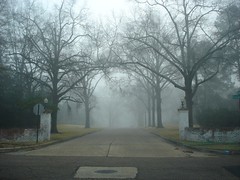
Wilder Place, S. Highlands, Shreveport; Talbot's block for many years
Originally uploaded by trudeau.
Photography test / technique, personalities, history / Trudeau
1. Nicephore Niepce and Louis Daguerre, pioneers of photography (see the Daguerreotype), were from __. a) England b) Germany c) France d) Croatia e) Greece.
2. William Henry Fox Talbot, developer of the Calotype (In Greek “Calo” means beauty), aka the Talbottype, was from __ (use choices above).
3. Ansel Adams’ home was a) San Francisco b) Yosemite Park c) Philadelphia d) Sacramento.
4) Clarence John Laughlin, author of the photographic tour Ghosts Along the Mississippi, was a resident of a) Baton Rouge b) New Orleans c) Gulfport, MS d) Lake Charles.
5) George Eastman, founder of Eastman Kodak, was a denizen of __
a) Philadelphia, PA b) Rochester, NY c) NYC d) Boston, MA.
6) While Matthew Brady, portraitist of the social class of America in the mid-1800’s, had a studio in NYC, he operated from his gallery in __ during the US Civil War (1861 - 1865). a) Washington, DC b) Philadelphia, PA
c) Rochester, NY d) Richmond, VA.
7) “The Wizard of Menlo Park,” aka the inventor & entrepreneur Thomas A. Edison, made his fortune while working from the state of a) NY b) NJ
c) Conn. d) Mass.
8) Yosemite National Park is in the __ mountains . a) California b) Rocky c) Appalachian d) Sierra Nevada.
9) Photos is a root which means Light and was derived from the a) Latin b) Greek c) Sanskrit d) Old English e) High German.
10) The belief that your culture or nation is superior to others is called
a) ethnocentrism b) fascism c) communism d) capitalism.
11) The Kinetoscope was a precedent-breaking development of __.
a) Louis & Auguste Lumiere b) Thomas Edison c) Mathew Brady d) Louis Daguerre.
12) One of the pioneers of photography became a mogul and philanthropist. This mega-successful entrepreneur was a) George Eastman b) Mathew Brady c) Louis Daguerre d) Ansel Adams.
Photography / Trudeau
13) Margaret Bourke-White, Jacob Riis, Gordon Parks; these imminent photographers were based in the municipality of __.
a) NYC b) Hollywood, CA c) Washington, DC d) London, UK.
14) The Leica camera, higher in status than even Hasselblad (Sweden) or Nikon (Japan), is a product of the outstanding lens design and mechanical innovation developed in the European nation of a) England b) Germany c) France d) Italy.
15) The word Camera actually means “room” in this language: a) Italian
b) Greek c) German d) English.
16) This photographer helped persuade Congress, via his photos, to set aside more land in the national wildlife program: a) Clarence John Laughlin
b) Jacob Riis c) Ansel Adams d) Mathew Brady.
17) The ancient Greek philosopher Aristotle observed that light passing through a small hole in the wall of a room formed an upside-down image of an object. The first crude camera, called a __ __ (dark chamber), consisted of a huge box with a tiny opening in one side that admitted light. a) camera obscura b) cave canem c) opus dei d) in vino, veritas.
18) The innovator whose products (roll film, etc.) made photography widespread and inexpensive: a) Samuel Kodak b) Mathew Brady c) George Eastman d) Thomas Edison.
19) The photographer who amassed the greatest number of photos (some 10,000) on one topic: a) Louis Daguerre b) Mathew Brady c) Thomas Edison d) George Eastman.
20) The journalists who were social reformers at the turn of the century were called muckrakers. Among them was a photojournalist who exposed the poverty of NYC’s immigrants and children: a) George Eastman b) Margaret Bourke-White c) Jacob Riis d) Thomas Edison.
Wednesday, January 25, 2006
Charlie Chaplin: actor, writer, producer, mogul
The first actor to earn a million dollar contract (in 1917), says Wikipedia, was silent-film star Charlie Chaplin. He was born British but Hollywood was his working home from 1918 through 1952.
He famously played The Little Tramp in his early movies and used sentimentality and slapstick humor to appeal to the masses.
He famously played The Little Tramp in his early movies and used sentimentality and slapstick humor to appeal to the masses.
Tuesday, January 24, 2006
Making a Photo Rules Booklet: 5 illustrations, at least 5 rules found
Students created a Photo Guide in their notebook using 5 illustrations and 5 rules. Plus there was a description of how each rule was portrayed in each photo.
New independent work:
Bring 8 to 10 photos from your recent shooting to class. Show them to the class and briefly point out the rules employed and improvements that were possible.
5 pts.
Don't forget:
a) Open notes on photography Thurs.
b) Matted photo for display on Mon, Jan 30.
c) Next unit: the Forces that strain the vast nation of India.
d) Coming up in 2 weeks: Yoga Day.
e) Pack scissors to school for our bi-weekly activities.
New independent work:
Bring 8 to 10 photos from your recent shooting to class. Show them to the class and briefly point out the rules employed and improvements that were possible.
5 pts.
Don't forget:
a) Open notes on photography Thurs.
b) Matted photo for display on Mon, Jan 30.
c) Next unit: the Forces that strain the vast nation of India.
d) Coming up in 2 weeks: Yoga Day.
e) Pack scissors to school for our bi-weekly activities.
Monday, January 23, 2006
Student Curriculum in Photography: from Santa Cruz, CA, to the globe
Student Curriculum in Photography is an online resource for students of all ages who want to improve their photography skills. This site was originally designed for students at Santa Cruz High School in Santa Cruz, California. Time has grown the site into a place where photo students from all over the world can come for extra help and a few photo challenges to help learn how to "make a photograph" rather than a simply taking a "snapshot" without thought for the finished product.
Light is the essence of the art of capturing images on film
RT's Guidelines in Lighting and Composition . . .
Ambient light is also known as Available light; it is what's there when you arrive. In C-4 the ambient light is a combination of flourescent and daylight.
Frontal light is usually provided by the flash unit.
* It is often a useful light, filling in untoward shadows and freezing the subject in place.
* It can also cause overexposure (too much light).
Side light is the professional's choice.
* It brings out the form's contours.
* It is indirect and flattering.
* Place your subject next to a window or move a lamp beside your subject to create side light.
Glamor Lighting, or rim lighting, is essentially back light.
* Confers upon the subject an aura of status and excitement.
* Light comes from a) above and b) behind the subject. See publicity pictures of celebrities.
* Strong light coming from behind the subject can a) separate the subject from the background
b) create a glamor effect
c) leave the front or face of the subject underexposed - be careful!
Rembrandt lighting comes from the side and above the subject's visage. It is romantic and dramatic. Study the paintings of the Dutch master to analyze and learn this style.
Composition
The S-curve: almost every element in nature - the beach, the human form - is composed of pleasing curves. Emphasize them for maximum appeal.
Rule of Thirds: divide your rectangular image field by 3 horizontal lines, equidistant, and 3 vertical lines. Place the strongest elements of your composition within the outer blocks. Designers say your composition will be more pleasing if it is not centered.
Red sweater effect: provide a center of interest for the viewer's eye by having one element that is brighter than the rest. Imagine the way that a person in a yellow or red sweater stands out from the crowd.
Get close. Bring the viewer more of the subject's personality, more of their face, their eyes, their expression, by getting close.
Cropping is cutting off parts of the subject that you feel are unnecessary. It flows with Getting Close.
Link the bodies: bring life to a group composition by having everyone crowd together and throw their arms across each other. It adds humor, smiles, and zest.
Use props: hats, sunglasses, beanie babies, crazy clothing, makeup, background music; a subject can be jazzed by the use of props.
Kapture kinetic energy: shoot to catch the action. Allow blur in the subject or background to imply movement.
Decisive moment: catch the peak of the action.
Vary the POV (point of view): shoot from high above your subject. Sometimes shoot while lying on your belly like a reptile.
When you know the rules and have demonstrated competency in them you can break the rules with comfort.
Ambient light is also known as Available light; it is what's there when you arrive. In C-4 the ambient light is a combination of flourescent and daylight.
Frontal light is usually provided by the flash unit.
* It is often a useful light, filling in untoward shadows and freezing the subject in place.
* It can also cause overexposure (too much light).
Side light is the professional's choice.
* It brings out the form's contours.
* It is indirect and flattering.
* Place your subject next to a window or move a lamp beside your subject to create side light.
Glamor Lighting, or rim lighting, is essentially back light.
* Confers upon the subject an aura of status and excitement.
* Light comes from a) above and b) behind the subject. See publicity pictures of celebrities.
* Strong light coming from behind the subject can a) separate the subject from the background
b) create a glamor effect
c) leave the front or face of the subject underexposed - be careful!
Rembrandt lighting comes from the side and above the subject's visage. It is romantic and dramatic. Study the paintings of the Dutch master to analyze and learn this style.
Composition
The S-curve: almost every element in nature - the beach, the human form - is composed of pleasing curves. Emphasize them for maximum appeal.
Rule of Thirds: divide your rectangular image field by 3 horizontal lines, equidistant, and 3 vertical lines. Place the strongest elements of your composition within the outer blocks. Designers say your composition will be more pleasing if it is not centered.
Red sweater effect: provide a center of interest for the viewer's eye by having one element that is brighter than the rest. Imagine the way that a person in a yellow or red sweater stands out from the crowd.
Get close. Bring the viewer more of the subject's personality, more of their face, their eyes, their expression, by getting close.
Cropping is cutting off parts of the subject that you feel are unnecessary. It flows with Getting Close.
Link the bodies: bring life to a group composition by having everyone crowd together and throw their arms across each other. It adds humor, smiles, and zest.
Use props: hats, sunglasses, beanie babies, crazy clothing, makeup, background music; a subject can be jazzed by the use of props.
Kapture kinetic energy: shoot to catch the action. Allow blur in the subject or background to imply movement.
Decisive moment: catch the peak of the action.
Vary the POV (point of view): shoot from high above your subject. Sometimes shoot while lying on your belly like a reptile.
When you know the rules and have demonstrated competency in them you can break the rules with comfort.
Buchenwald death camp, near Weimar, Germany, photo Margaret Bourke-White
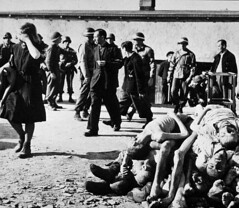
Buchenwald death camp, near Weimar, Germany, photo Margaret Bourke-White
Originally uploaded by trudeau.
Life Magazine was one of the greatest photo journals of that era and she distinguished herself as a Life staffer. In the 1930's she shot photos of American poverty. In the 1940's she covered WWII in Europe, going so far as to ride in bombers during raids. One of her contributions was to document the American discoveries in the Nazi death camps about 1945.
From a Univ of Iowa site:
Margaret Bourke-White was with General Patton's third amy when they reached Buchenwald on the outskirts of Weimar. Patton was so incensed by what he saw that he ordered his police to get a thousand civilians to make them see with their own eyes what their leaders had done. The MPs were so enraged they brought back 2,000. Bourke-White said, "I saw and photographed the piles of naked, lifeless bodies, the human skeletons in furnaces, the living skeletons who would die the next day... and tattoed skin for lampshades. Using the camera was almost a relief. It interposed a slight barrier between myself and the horror in front of me." LIFE published in their May 7, 1945 issue many photographs of these atrocities, saying, "Dead men will have indeed died in vain if live men refuse to look at them."
Speed Graphic camera: photojournalists' choice for decades
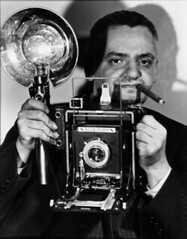
Speed Graphic camera: photojournalists' choice for decades / Here's WeeGee
Originally uploaded by trudeau.
Riis was Danish and was impoverished when he came to NYC. As a photojournalist he was sympathetic to the immigrants struggling to find education and jobs while living in wretched tenements. His book on poverty in NYC, How the Other Half Lives, is a landmark work in US history.
Riis was a crusading journalist, unafraid to oppose the authorities and wealthy class. He was of a group called the muckrakers.
After the muckrakers stirred the public, legislators passed laws protecting Americans from abuses in
* child labor
* sanitary housing
* workplace safety
* safe medicine
* safe food
Riis was one of the first to use flash in photojournalism. He presented lectures across the nation to America's comfortable class on the deleterious effects of urban poverty.
Manhattan map, 2nd semester: Brady, Edison, Riis, Bourke-White, etc.
As in most fields, many people of great photographic expertise lived in Manhattan.
* Hudson R, East R, harbor & Atlantic
* boroughs: Manhattan, Bronx, Brooklyn, Queens, Staten Is.
* Central Park, Wall St financial district / WTC / Ground Zero
* Lower east Side / Chinatown / history of poor immigrants
* Harlem
* Columbia U, NYU
* Times Square, Empire State Bldg, Chrysler Bldg.
Other vocab:
* Janus, the twin-headed Roman god
* subsidized - when someone else takes care of your expenses.
* Phi Beta Kappa - honorary society of A+ college students.
* tenements vs. shotgun houses: housing for the urban poor.
World's high-status and most expensive cameras:
* Hasselblad (Swedish)
* Leica (German))
* Nikon (japanese)
* Hudson R, East R, harbor & Atlantic
* boroughs: Manhattan, Bronx, Brooklyn, Queens, Staten Is.
* Central Park, Wall St financial district / WTC / Ground Zero
* Lower east Side / Chinatown / history of poor immigrants
* Harlem
* Columbia U, NYU
* Times Square, Empire State Bldg, Chrysler Bldg.
Other vocab:
* Janus, the twin-headed Roman god
* subsidized - when someone else takes care of your expenses.
* Phi Beta Kappa - honorary society of A+ college students.
* tenements vs. shotgun houses: housing for the urban poor.
World's high-status and most expensive cameras:
* Hasselblad (Swedish)
* Leica (German))
* Nikon (japanese)
Photo Show by geo students: your matte-mounted shot due on Mon, Jan 30
Show that you can follow the photographic rules we've studied! Choose S-curve, side lighting, decisive moment or another rules (or rules) to portray in the best photo you can make.
The Trudeau / Geography Photo Exhibit will last one week. Photos will be exhibited on a folding art display panel in the library. The nature of the display panel means that that these photos must Not be framed.
Please purchase a matte board (also spelled mat) - a cardboard frame - from Walgreen's, Michael's, Hobby Lobby or any store that carries your basic poster board-type stuff. The matte should fit around a 5X7 or 4X6 print. It will cost about $1.87.
The matte frame will give your photo extra impact. It is part of recognizing the power of neat and careful presentation tools. The beveled, precise cuts are almost impossible to duplicate at home.
Mattes can be color-keyed to enhance certain hues in your photo. Bring your photo with you to the craft store when choosing your matte and you will find terrific options.
If you don't have a camera, please shoot a photo at CMHS using the classroom camera. You need Not print out your photo on traditional glossy paper. You can print it on any copier, including the one in the school library.
15 pts.
The Trudeau / Geography Photo Exhibit will last one week. Photos will be exhibited on a folding art display panel in the library. The nature of the display panel means that that these photos must Not be framed.
Please purchase a matte board (also spelled mat) - a cardboard frame - from Walgreen's, Michael's, Hobby Lobby or any store that carries your basic poster board-type stuff. The matte should fit around a 5X7 or 4X6 print. It will cost about $1.87.
The matte frame will give your photo extra impact. It is part of recognizing the power of neat and careful presentation tools. The beveled, precise cuts are almost impossible to duplicate at home.
Mattes can be color-keyed to enhance certain hues in your photo. Bring your photo with you to the craft store when choosing your matte and you will find terrific options.
If you don't have a camera, please shoot a photo at CMHS using the classroom camera. You need Not print out your photo on traditional glossy paper. You can print it on any copier, including the one in the school library.
15 pts.
Digital cameras: silicon and pixels
Digital Camera Basics
From Peter Marshall, About.com / Photography.
Cells and Pixels:
In digital cameras the light-sensitive medium is a silicon chip covered with a regular pattern of very small light sensitive circuits.
When a few photons hits one of these it causes a few electrons to flow in a circuit. These electrical signals are then amplified and converted into a digital format.
Each cell in most sensors is covered by a red, green or blue filter (RGB), so that only light of that colour can reach it. The 'raw' image that contains the digital values for these separate RGB sites is then mathematically converted into pixels - values for red green and blue at a particular point.
Pixel count alone gives a poor idea of a camera's capabilities.
Many images used professionally have been taken on cameras with only 2-3 Megapixels. A greater number of pixels will not improve image quality if the information they provide is less reliable. A 5mp or 6mp camera should be able to produce decent prints at up to A3 size.
Sensor size
Consumer cameras use small sensors, only a few millimetres in each dimension, making the individual pixels very small. Professional cameras use larger sensors - so that the individual cells are perhaps 5-10 times the area and are also better separated. The larger cells capture more light for the same exposure, giving electrical signals that need less amplification and have less random noise (fuzziness).
Sunday, January 22, 2006
Photography test on Th, Jan 26 / open notes, multiple-choice
Photography is a global story: from San Francisco to Paris to Rochester to Frankfurt (the Leica camera). It is a story of burgeoning technology: from Daguerreotypes to roll film to pixels. And it's a story of social impact: Brady and the US Civil War, Adams and the national forests, Riis and NYC poverty, Life Magazine and the world in the 1950's and 1960's (ex: the Civil Rights movement).
Today's photo is a famous one by photojournalist Margaret Bourke-White. Taken during the Great Depression (1930 - 1940), this photo of jobless people in a line for a soup kitchen shows the ironic nature of US government propaganda.
Bonus / independent work:
* Research & compare photojournalists Henri Cartier-Bresson and Gordon Parks.
* Research & compare artist Andy Warhol and celeb photog Annie Leibovitz.
* Research & compare National Geographic Magazine and Life Magazine.
* Research & compare the Polaroid camera with the digital camera.
Objectives:
* Explain how technological advances have led to increasing interaction between
regions (e.g., use of satellites for monitoring and exploration) (G-1B-H3)
* Identify technological advances that expanded human capacity to
modify the environment (e.g., steam, coal, electric, nuclear power,
levees) (G-1D-H1)
Today's photo is a famous one by photojournalist Margaret Bourke-White. Taken during the Great Depression (1930 - 1940), this photo of jobless people in a line for a soup kitchen shows the ironic nature of US government propaganda.
Bonus / independent work:
* Research & compare photojournalists Henri Cartier-Bresson and Gordon Parks.
* Research & compare artist Andy Warhol and celeb photog Annie Leibovitz.
* Research & compare National Geographic Magazine and Life Magazine.
* Research & compare the Polaroid camera with the digital camera.
Objectives:
* Explain how technological advances have led to increasing interaction between
regions (e.g., use of satellites for monitoring and exploration) (G-1B-H3)
* Identify technological advances that expanded human capacity to
modify the environment (e.g., steam, coal, electric, nuclear power,
levees) (G-1D-H1)
Friday, January 20, 2006
Basic problems and guidelines in videography
The most prevalent problem in video is audio. Your lens zooms, but your cameraa's mic stays put. And people in front of a video cam typically speak in a soft voice. Argh. Cannot understand 'em.
Here are my solutions:
* Get close. Get the mic as close to people's mouths as possible by getting the camera right into their faces. Really.
* Silent movie. Use subtitles. Sometimes you can effectively put the printed dialogue or explanations right on top of that shot.
* Silent movie with voice-overs. Record your spoken parts after you've edited the silent movie. Easy to do and might produce humorous effect.
* Buy a lapel mic with long cable to plug into your camera. Not All cameras have such an input. Also, lapel mics are not perfect. An electret condenser mic with 15' cable sells for about $19 on Amazon.
Shaky, needlessly moving camera! American amateurs love to pan their camera across landscapes. For good camera technique, go watch a few movies. The camera stays still, mostly. Action flows into and out of the steady frame.
Use a tripod. People think "Oh, I've got a very steady hand. I don't need a tripod." Sorry, but that is probably Not as true as you think. If you don't have a tripod, learn to make steady shots by bracing the cam against a wall, a sign, a chair, a cabinet, etc.
Also, avoid using the zoom during your shots.
Lighting problems remain the same in all types of photography. A classic complaint is "The faces are too dark!" Be careful to have extra light for dark-skinned African-Americans. Avoid using too much light on pale-skinned Euro-types.
Batteries. You simply must have extra batteries.
Film. Having extra film is Never a bad idea.
Here are my solutions:
* Get close. Get the mic as close to people's mouths as possible by getting the camera right into their faces. Really.
* Silent movie. Use subtitles. Sometimes you can effectively put the printed dialogue or explanations right on top of that shot.
* Silent movie with voice-overs. Record your spoken parts after you've edited the silent movie. Easy to do and might produce humorous effect.
* Buy a lapel mic with long cable to plug into your camera. Not All cameras have such an input. Also, lapel mics are not perfect. An electret condenser mic with 15' cable sells for about $19 on Amazon.
Shaky, needlessly moving camera! American amateurs love to pan their camera across landscapes. For good camera technique, go watch a few movies. The camera stays still, mostly. Action flows into and out of the steady frame.
Use a tripod. People think "Oh, I've got a very steady hand. I don't need a tripod." Sorry, but that is probably Not as true as you think. If you don't have a tripod, learn to make steady shots by bracing the cam against a wall, a sign, a chair, a cabinet, etc.
Also, avoid using the zoom during your shots.
Lighting problems remain the same in all types of photography. A classic complaint is "The faces are too dark!" Be careful to have extra light for dark-skinned African-Americans. Avoid using too much light on pale-skinned Euro-types.
Batteries. You simply must have extra batteries.
Film. Having extra film is Never a bad idea.
Kodak ad used about 1900 by entrepreneur/inventor George Eastman
The life of George Eastman, Like Henry Ford and John Rockefeller, looms on the world stage.
Our class will use several sites as we attempt to measure his impact on technology and social studies. One site is for the PBS.org biography called The Wizard of Photography.
Our class will use several sites as we attempt to measure his impact on technology and social studies. One site is for the PBS.org biography called The Wizard of Photography.
Writers' Workshop continues Weds. after school, 3:40 to 4:10
Writers' Workshop is a weekly after-school session in which I give a small group of students individualized attention. Each Wed. for about 30 mins. students write an essay and get immediate feedback and bonus points.
For more info call me at 861-6809 or email me at trudeau@earthlink.net.
For more info call me at 861-6809 or email me at trudeau@earthlink.net.
Thursday, January 19, 2006
Please see Oprah's national high school essay contest - bonus points if you write the essay
Oprah's national high school essay contest:
"WHY IS ELIE WIESEL'S BOOK NIGHT RELEVANT TODAY?"
If you are a high school student who has read, is reading, or will be reading Night—enter Oprah's National High School Essay Contest!
Print Your Official Entry and Permission Form.
This entry form contains your essay topic, guidelines for formatting your essay and the criteria it will be judged by. It must be completed and signed and included with your essay in order for you to be considered eligible for Oprah's National High School Essay Contest.
Entries must be postmarked by Monday, February 6, 2006 and received by February 9, 2006—so start planning your essay today.
Bonus points for your essays for geography class!
"WHY IS ELIE WIESEL'S BOOK NIGHT RELEVANT TODAY?"
If you are a high school student who has read, is reading, or will be reading Night—enter Oprah's National High School Essay Contest!
Print Your Official Entry and Permission Form.
This entry form contains your essay topic, guidelines for formatting your essay and the criteria it will be judged by. It must be completed and signed and included with your essay in order for you to be considered eligible for Oprah's National High School Essay Contest.
Entries must be postmarked by Monday, February 6, 2006 and received by February 9, 2006—so start planning your essay today.
Bonus points for your essays for geography class!
From the Mathew Brady Studios, NYC and Washington, DC
Following the thread of photography / technology and the ways it has affected men and regions . . .
The story of master photographer Mathew Brady is touching. He is the first declared photographic historian of America, says American Memories, the Library of Congress site. He built success as a social portraitist (studios in both NYC and Wash, DC) but over-invested in his coverage of the US Civil War. He spent $100,000 assembling 10,000 photos of that war, says the LOC. He died penniless and broken because no one wanted to pay for the photos of this horrendous war during the sober aftermath.
* Sketch a map of the states east of the Mississippi. Many Louisianians don't whether Connecticut is north or south of NYC or whether Pennsylvania is above or below Massachusetts.
* Identify and outline the 11 secessionist states.
Vocab:
secede / secessionist
confederate
emancipate / manus / manual
Battle of Bull Run / Manassas / outside Wash, DC
Battle of Antietam, MD, 1862: Confederate forces under General Lee were caught by General McClellan near Sharpsburg, Maryland. This battle proved to be the bloodiest day of the war; 2,108 Union soldiers were killed and 9,549 wounded -- 2,700 Confederates were killed and 9,029 wounded. The battle had no clear winner, but because General Lee withdrew to Virginia, McClellan was considered the victor. The battle convinced the British and French -- who were contemplating official recognition of the Confederacy -- to reserve action, and gave Lincoln the opportunity to announce his Preliminary Emancipation Proclamation (September 22), which would free all slaves in areas rebelling against the United States, effective January 1, 1863. - Library of Congress
Battle of Gettysburg, PA, 1963: Gen. Meade defeated Gen. Lee but failed to pursue him to a conclusive vistory. The LOC says, "Militarily, the Battle of Gettysburg was the high-water mark of the Confederacy; it is also significant because it ended Confederate hopes of formal recognition by foreign governments."
Glass plate photos: "During the Civil War, the process of taking photographs was complex and time-consuming. Two photographers would arrive at a location. One would mix chemicals and pour them on a clean glass plate. After the chemicals were given time to evaporate, the glass plate would be sensitized by being immersed -- in darkness -- in a bath solution. Placed in a holder, the plate would then be inserted in the camera, which had been positioned and focused by the other photographer. Exposure of the plate and development of the photograph had to be completed within minutes; then the exposed plate was rushed to the darkroom wagon for developing. Each fragile glass plate had to be treated with great care after development -- a difficult task on a battlefield."
Please see the section called "Does the camera ever lie?"
The story of master photographer Mathew Brady is touching. He is the first declared photographic historian of America, says American Memories, the Library of Congress site. He built success as a social portraitist (studios in both NYC and Wash, DC) but over-invested in his coverage of the US Civil War. He spent $100,000 assembling 10,000 photos of that war, says the LOC. He died penniless and broken because no one wanted to pay for the photos of this horrendous war during the sober aftermath.
* Sketch a map of the states east of the Mississippi. Many Louisianians don't whether Connecticut is north or south of NYC or whether Pennsylvania is above or below Massachusetts.
* Identify and outline the 11 secessionist states.
Vocab:
secede / secessionist
confederate
emancipate / manus / manual
Battle of Bull Run / Manassas / outside Wash, DC
Battle of Antietam, MD, 1862: Confederate forces under General Lee were caught by General McClellan near Sharpsburg, Maryland. This battle proved to be the bloodiest day of the war; 2,108 Union soldiers were killed and 9,549 wounded -- 2,700 Confederates were killed and 9,029 wounded. The battle had no clear winner, but because General Lee withdrew to Virginia, McClellan was considered the victor. The battle convinced the British and French -- who were contemplating official recognition of the Confederacy -- to reserve action, and gave Lincoln the opportunity to announce his Preliminary Emancipation Proclamation (September 22), which would free all slaves in areas rebelling against the United States, effective January 1, 1863. - Library of Congress
Battle of Gettysburg, PA, 1963: Gen. Meade defeated Gen. Lee but failed to pursue him to a conclusive vistory. The LOC says, "Militarily, the Battle of Gettysburg was the high-water mark of the Confederacy; it is also significant because it ended Confederate hopes of formal recognition by foreign governments."
Glass plate photos: "During the Civil War, the process of taking photographs was complex and time-consuming. Two photographers would arrive at a location. One would mix chemicals and pour them on a clean glass plate. After the chemicals were given time to evaporate, the glass plate would be sensitized by being immersed -- in darkness -- in a bath solution. Placed in a holder, the plate would then be inserted in the camera, which had been positioned and focused by the other photographer. Exposure of the plate and development of the photograph had to be completed within minutes; then the exposed plate was rushed to the darkroom wagon for developing. Each fragile glass plate had to be treated with great care after development -- a difficult task on a battlefield."
Please see the section called "Does the camera ever lie?"
Phonograph, light bulb and movie camera-projector (kinetoscope): Thomas Edison
"The wizard of Menlo Park" was Thomas Edison's nickname. He assembled a team of canny engineers and guided them to the creation of items such as the phonography, incandescent light bulb and motion picture camera & projector.
Edison was also successful as a businessman and father. See more on his work at the American Memory site of the Library of Congress.
He and his contemporaries, such as Henry Ford, were part of a shift of power from Europe, home of the industrial revolution, to America. In the 1890's America's inventors and developers were highly successful.
Edison was also successful as a businessman and father. See more on his work at the American Memory site of the Library of Congress.
He and his contemporaries, such as Henry Ford, were part of a shift of power from Europe, home of the industrial revolution, to America. In the 1890's America's inventors and developers were highly successful.
Louis Daguerre and the Daguerreotype, 1840's - 1860's
Frenchman Louis Daguerre - alongside French inventor Nicephore Niepce - developed the first form of mass photography. His Daguerreotypes were photos on a metal plate, enclosed in a jewel case. Many people - usch as George eastman and Matthew Brady - got their start in this form of picture-making.
See more of them at the Library of Congreess site called American Memories. Please see Daguerreotypes.
See more of them at the Library of Congreess site called American Memories. Please see Daguerreotypes.
Saturday, January 14, 2006
Guidelines for the Social Studies Scientific Method paper
Choose 1. Narrative or 2. PowerPoint
Open with your Question. Proceed to develop a hypothesis.
Literature review: Excerpt appropriate quotes and paraphrased segments from a variety of sources. Follow each new section with the informal documentation of "according to ..."
In the Conclusion you must summarize the and analyze the research, forging an answer to the hypothesis.
Self evaluation is trying to answer the question What did I do best and What improvements might I have made in this paper?
A simple listing of sources, alphabetized, will end the paper.
No fancy covers or title sheet, please! A staple will be fine.
Good luck. Completion is the key!
Open with your Question. Proceed to develop a hypothesis.
Literature review: Excerpt appropriate quotes and paraphrased segments from a variety of sources. Follow each new section with the informal documentation of "according to ..."
In the Conclusion you must summarize the and analyze the research, forging an answer to the hypothesis.
Self evaluation is trying to answer the question What did I do best and What improvements might I have made in this paper?
A simple listing of sources, alphabetized, will end the paper.
No fancy covers or title sheet, please! A staple will be fine.
Good luck. Completion is the key!
Thursday, January 12, 2006
Tiger Leaps in to the water! (must see large) I'm going to really miss these guys ;(
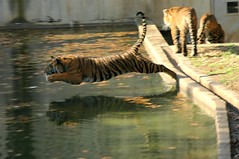
Tiger Leaps in to the water! (must see large) I'm going to really miss these guys ;(
Originally uploaded by Nikographer.
Describing techniques in composition and lighting via a narrative.
Within the format of a situation in which you’ll be using your photography skills - at school, at a church meeting, on a field trip, at a game, etc. - describe how you will use 3 techniques of photography. Most importantly, describe Why you will use them and the Way in which they’ll put into practice.
* Titling: a) snappy title and b) explanatory subtitle.
* Colorful opening:
a) quote
b) description or
c) question.
* Grammar & spelling.
* Organization.
* Attribution, or documentation: “according to teacher Robert Trudeau."
* Essay 15 pts.
Wednesday, January 11, 2006
Spanish Moss in the Swamp: one of the typical and most appealing shots of this region
While the shot above is a flickr.com image from a Georgia lake, many people think of Louisiana when they see such a capture.
Here's your (optional) assignment:
Got to a lake near sunset. Find the most attractive cypress tree composition. Shoot the combo of water, sunset and cypress for a bayou state classic.
Here's your (optional) assignment:
Got to a lake near sunset. Find the most attractive cypress tree composition. Shoot the combo of water, sunset and cypress for a bayou state classic.
POV: unusual point of view makes most subjects more interesting
This flickr.com shot of Tara represents extreme POV, but there are many ways to demonstrate an unusual POV besides by shooting from high or low.
Side lighting. Wow. Full of mood, artistry and it brings out the contoiurs of the subject.
Side lighting and an artistically cool black & white rendering, and it's a close shot, too: this would be an award-wining shot in a student art show.
Try one!
Try one!
Photo rules in action: Kickflip at the s-curve
It's called the Decisive Moment because he is in the air.
Kinetic Energy is seen in the strain of his muscles, the tumble of the board, his wide-flung arms and hair.
Kinetic Energy is seen in the strain of his muscles, the tumble of the board, his wide-flung arms and hair.
Jump! Using effective composition and lighting in social studies-minded photography
Quiz on rules of photography and notable photogs Th, Jan 12. Sample questions -
* You try to capture your friend as she jumps from the diving board and springs through the air in an arc toward the water. Kinetic action!
* Four of your friends are standing in a group, waiting for you to shoot with your new camera. You realize the composition is somewhat boring. "At the count of three," you say, "everyone jump!" In 3 shots you've captured them in mid-air. Your shot has verve and style because you have captured the Decisive Moment.
* You look great tonight! Let me shoot your portrait on that sofa. Sit next to the lamp. You're using Side Lighting.
* "I've got to capture your eyes; they're gorgeous." To do that I'm going to follow Mr. T's most important rule: Get Close.
* "Throw your arms over each other's shoulders," you say, ready with the camera to catch the smiles that follow this command. You are happy that you decided to Link the Bodies.
* Graphy is the Greek word for __.
Writing!
* Photos is the Greek root which refers to __.
Light!
* Clarence John Laughlin is one of the most famouis photographers from the city of __.
New Orleans.
* Yosemite Park is in the __ mountains.
Sierra Nevada.
Thanks to Dakota Johnson for bringing in a 1940's Kodak Brownie camera. Made of bakelite, the camera used non-cartridge roll film and the photog viewed the scene by looking down upon the camera into the viewfinder.
Thanks to Chris Jay of Robinson Film center for visiting Picasso Digital Arts club and talking about LaFilmFest.org. It is a contest hosted by the RFC and Centenary College for student videos. He loaned us "The Ninja Mummy," an entertaining 7-minute video story made by kids at Renzi Center.
While Clarence John Laughlin is one of Louisiana's most famous photographers, perhaps even better known to historians is turn-of-the-century French Quarter resident E.J. Bellocq. His photos of the prostitutes of Storyville, New Orleans legal red light district of the 1890's (closed by request of the Federal government about 1914), constituted a touching historic record. He gained the trust of the working girls and did not take salacious photos. While some of the models are undraped, many of them were fully clothed and looked quite sober.
C.C. Lockwood is one of Louisiana's most prominent contemporary photogs. His specialty is wildlife, especially the coast and Atchafalaya basin, and he has won the Ansel Adams award for conservation photography. Please see his posters and books at cclockwood.com.
* You try to capture your friend as she jumps from the diving board and springs through the air in an arc toward the water. Kinetic action!
* Four of your friends are standing in a group, waiting for you to shoot with your new camera. You realize the composition is somewhat boring. "At the count of three," you say, "everyone jump!" In 3 shots you've captured them in mid-air. Your shot has verve and style because you have captured the Decisive Moment.
* You look great tonight! Let me shoot your portrait on that sofa. Sit next to the lamp. You're using Side Lighting.
* "I've got to capture your eyes; they're gorgeous." To do that I'm going to follow Mr. T's most important rule: Get Close.
* "Throw your arms over each other's shoulders," you say, ready with the camera to catch the smiles that follow this command. You are happy that you decided to Link the Bodies.
* Graphy is the Greek word for __.
Writing!
* Photos is the Greek root which refers to __.
Light!
* Clarence John Laughlin is one of the most famouis photographers from the city of __.
New Orleans.
* Yosemite Park is in the __ mountains.
Sierra Nevada.
Thanks to Dakota Johnson for bringing in a 1940's Kodak Brownie camera. Made of bakelite, the camera used non-cartridge roll film and the photog viewed the scene by looking down upon the camera into the viewfinder.
Thanks to Chris Jay of Robinson Film center for visiting Picasso Digital Arts club and talking about LaFilmFest.org. It is a contest hosted by the RFC and Centenary College for student videos. He loaned us "The Ninja Mummy," an entertaining 7-minute video story made by kids at Renzi Center.
While Clarence John Laughlin is one of Louisiana's most famous photographers, perhaps even better known to historians is turn-of-the-century French Quarter resident E.J. Bellocq. His photos of the prostitutes of Storyville, New Orleans legal red light district of the 1890's (closed by request of the Federal government about 1914), constituted a touching historic record. He gained the trust of the working girls and did not take salacious photos. While some of the models are undraped, many of them were fully clothed and looked quite sober.
C.C. Lockwood is one of Louisiana's most prominent contemporary photogs. His specialty is wildlife, especially the coast and Atchafalaya basin, and he has won the Ansel Adams award for conservation photography. Please see his posters and books at cclockwood.com.
Subscribe to:
Posts (Atom)
